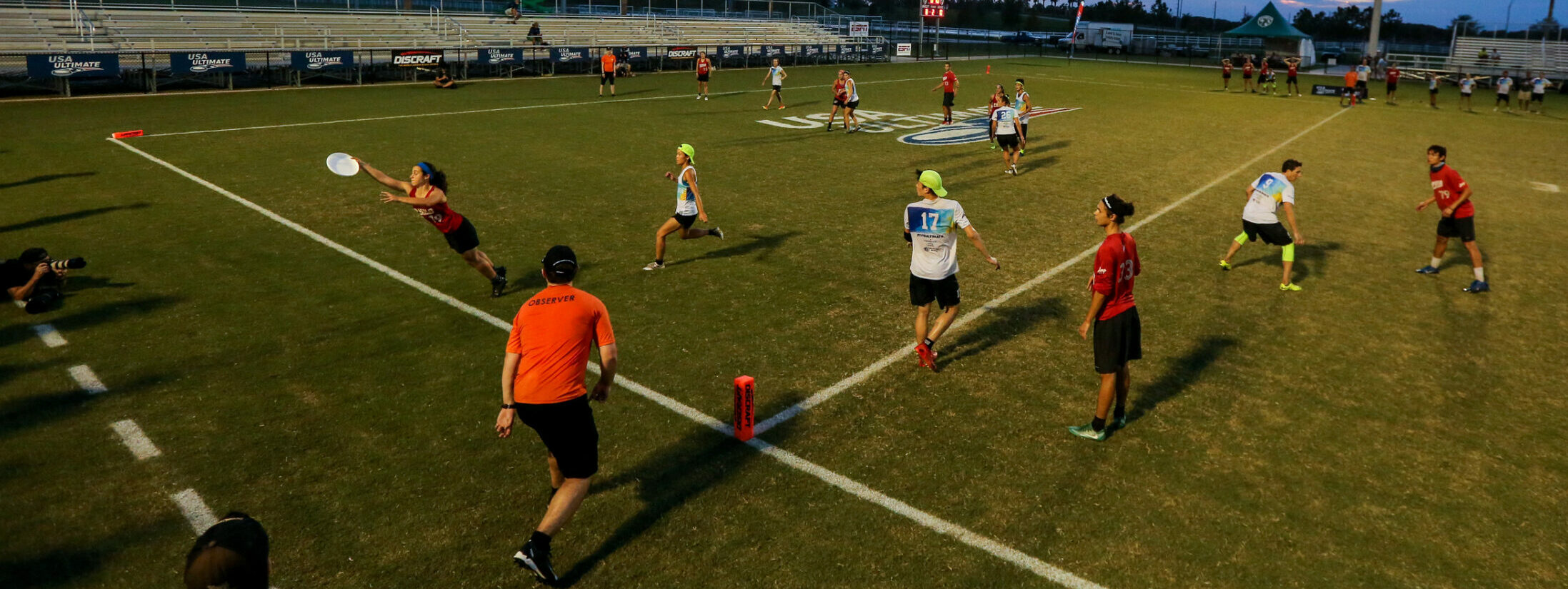

Table of Contents
- Introduction
- Spirit of the Game
- Definitions
- Playing Field
- Equipment
- Game Structure
- Timeouts
- Player Substitutions
- The Pull
- Restarting and Continuing Play
- In- and Out-of-bounds
- End Zone Possession
- Scoring
- Turnovers
- Stalling
- Marking Violations
- Making and Resolving Calls
- Travels
- Picks
- Fouls
- Positioning
- Observers
- Etiquette
Ultimate is a sport that inspires players and fans alike because of its ability to develop and showcase the athleticism, skill, teamwork, and character of its participants. The arc of the disc in flight, the opportunity for each individual to contribute equally to their team’s success, and the trust given to each player to know and uphold the rules make ultimate a sport that is embraced for its fun and excitement on the field and for the community beyond it. As a low-cost sport requiring minimal equipment, offering single- and mixed-gender play, and providing a format that builds communication and conflict resolution skills, ultimate provides a welcoming, high value experience for players and fans from a diverse set of backgrounds and experiences. The Official Rules of Ultimate 2026-2027 describes how the game is played, including how players self-officiate and apply the principles of Spirit of the Game in competition.
-
1. Introduction
- 1.A. Description: Ultimate is a non-contact, self-officiated disc sport played by two teams of seven players. The object of the game is to score goals. A goal is scored when a player catches any legal pass in the end zone that player is attacking. A player may not run while holding the disc. The disc is advanced by passing it to other players. The disc may be passed in any direction. Any time a pass is incomplete, a turnover occurs, resulting in an immediate change of the team in possession of the disc. Players are empowered to self-officiate using a framework governed by the principles of Spirit of the Game.
-
1.B. Rules Variations
- 1.B.1. Appendices included in these rules outline rules changes and additions specific to several variations of the sport.
- 1.B.2. Event Organizer Clause: The event organizer may modify rules relating to game logistics in order to suit the event. Examples include game length (game total), time limits (time caps), halftime length, number of timeouts, starting time point assessments, uniform requirements, and observer operations. Any such change must be established before competition starts.
- 1.B.3. Captain’s Clause: For games not subject to the event organizer clause, a game may be played under any variation of the rules agreed upon by the captains of the teams involved. Otherwise, any rules variations are subject to approval by the event organizer.
- 1.C. General vs. Specific Rules: Many of these rules are general in nature and cover most situations. However, some rules cover specific situations and override the general case.
-
2. Spirit of the Game
- 2.A. Spirit of the Game is a set of principles which places the responsibility for fair play on the player. Highly competitive play is encouraged, but never at the expense of the three core tenets of Spirit of the Game: mutual respect among competitors, adherence to the agreed upon rules, and the basic joy of play.
- 2.B. All players are responsible for knowing, administering, and adhering to the rules. The integrity of ultimate depends on each player’s responsibility to uphold Spirit of the Game, and this responsibility should remain paramount.
-
2.C. It is assumed that no player will intentionally violate the rules; thus there are no harsh penalties for inadvertent infractions, but rather a method for resuming play in a manner that simulates what most likely would have occurred absent the infraction. An intentional infraction is cheating and considered a gross offense against the Spirit of the Game. Players are obligated to abide by the rules and not gain advantage by knowingly committing an infraction, or calling one where none exists.
- 2.C.1. If a player intentionally or flagrantly violates the rules, the captains of each team should discuss the incident and determine an appropriate outcome, and are not bound by any outcome dictated by these rules.
- 2.C.2. For behavior warranting sanctions pursuant to Appendix C The Misconduct System, team captains or coaches may remove players on their team from the game for one point or any longer duration, to help promote Spirit of the Game. Removal shall occur after a point has been scored and before the next pull. However, in cases of ejection-worthy behavior, removal can occur at the next stoppage of play during the current point, with permission of the opposing captain. Spirit captains should be consulted prior to removal of a player. A captain or coach may permit a removed player to return to play at any time, consistent with rules on substitutions. If a player is substituted by a team in accordance with this rule, the other team may substitute a player.
-
2.D. Players should be mindful of the fact that they are acting as officials in any arbitration between teams. Players must:
- 2.D.1. know and abide by the rules;
- 2.D.2. make calls only where an infraction is significant enough to make a difference to the outcome of the action or where a player’s safety is at risk;
- 2.D.3. be fair-minded and objective;
- 2.D.4. be truthful;
- 2.D.5. explain their viewpoint clearly and concisely;
- 2.D.6. allow opponents an opportunity to speak;
- 2.D.7. listen to and consider opponent’s viewpoint;
- 2.D.8. treat your opponents with consideration;
- 2.D.9. be conscious of the impact of your words and body language;
- 2.D.10. resolve disputes efficiently;
- 2.D.11. make calls in a consistent manner throughout the game and from player to player; and
- 2.D.12. acknowledge potential bias and preconceptions in order to treat every player equitably.
-
2.E. The following are examples of actions to support good Spirit. While the absence of these actions is not necessarily an indication of poor Spirit, the examples illustrate ways to uphold core tenets of Spirit of the Game:
- 2.E.1. playing safely by actively avoiding unnecessary body contact;
- 2.E.2. working as a team to ensure that all players have an excellent knowledge of the rules;
- 2.E.3. bringing up Spirit issues with opponents as early as possible;
- 2.E.4. establishing lines of communication to address Spirit and safety issues (e.g. Spirit captain pregame and halftime meetings; calling a Spirit timeout if needed);
- 2.E.5. informing a teammate if they have made a wrong or unnecessary call, caused a foul or violation, or need a clarification of a rule;
- 2.E.6. retracting a call when you no longer believe the call was necessary or believe that it was made in error and should not have been called;
- 2.E.7. acknowledging exciting plays and good Spirit by both teams;
- 2.E.8. checking in with an opponent on the sideline after a contentious interaction;
- 2.E.9. making and/or discussing calls about contact that could be considered a foul in order to keep players safe;
- 2.E.10. connecting with or introducing yourself to an opponent on the sideline;
- 2.E.11. keeping communication open and engaging in a way that seeks to de-escalate disputed situations; and
- 2.E.12. participating in a pre- or post-game Spirit circle that includes Spirit highlights and constructive Spirit feedback (if needed) for each team;
-
2.F. The following actions are clear violations of Spirit of the Game and must be avoided by all participants:
- 2.F.1. reckless play or dangerously aggressive behavior;
- 2.F.2. intentional fouling or other intentional rule violations;
- 2.F.3. taunting or intimidating opposing players;
- 2.F.4. celebration that is targeted towards an opponent in a negative or aggressive manner;
- 2.F.5. intentionally damaging equipment;
- 2.F.6. intentional interference by a non-player with an in-play disc in the air;
- 2.F.7. making calls in retaliation to an opponent’s calls or other actions;
- 2.F.8. allowing preconceived expectations, biases (e.g., microaggressions), or previous interactions or encounters with a player or team to affect how game situations are reacted to and judged; and
- 2.F.9. other win-at-all-costs behavior.
-
2.G. Teams are guardians of Spirit of the Game, and must:
- 2.G.1. take responsibility for teaching their players the rules and good Spirit;
- 2.G.2. hold team members accountable when they display poor Spirit;
- 2.G.3. provide constructive feedback to other teams about what they are doing well and/or how to improve their adherence to Spirit of the Game; and
-
2.G.4. be aware regarding the potential for implicit biases to impact play and Spirit of the Game.
- 2.G.4.a. Players and team leaders should acknowledge and recognize that the implementation of Spirit of the Game is susceptible to bias. Team leaders should be mindful of and encourage their teammates to be mindful of their own biases when considering and discussing interactions with, and impressions of, other teams as well as their own team. Understand that intent and impact are not the same. The intent of a person’s statement or gesture may be neutral or positive to them, but the impact of what they say or do may be harmful or hurtful to others.
- 2.H. In the case where a novice player commits an infraction out of ignorance of the rules, experienced players are obliged to explain the infraction and clarify what should happen.
-
3. Definitions
-
3.A. Best perspective: The most complete view available by a player that includes the relative positions of the disc, ground, players, and line markers involved in a play. On an unlined field, this may require sighting from one field marker to another. Best perspective always belongs to a player. However, players may rely on the following sources as a component of best perspective:
-
3.A.1. Players may seek the perspective of sideline players to clarify the rules and to assist players in making the appropriate call. Players may seek the perspective of coaches to clarify a rule, but not to assist in making the appropriate call.
- 3.A.1.a. Sideline players should not offer their perspective unless solicited by a player. However, a sideline player may offer perspective without being asked by a player if the perspective offered is to the detriment of the sideline player’s team.
- 3.A.2. Players may review officially-designated video footage to assist in resolving a call where such footage is available. However, play may not be delayed to review video footage. [[For example, live instant replay in a stadium setting may be used by players to resolve a contested foul call. Players may not, however, request that a particular play be replayed on the screen. If, after reviewing the video, players still cannot agree, they should not delay the game to rewatch the play multiple times; instead, the play should be treated as a regular contested foul.]]
-
3.A.1. Players may seek the perspective of sideline players to clarify the rules and to assist players in making the appropriate call. Players may seek the perspective of coaches to clarify a rule, but not to assist in making the appropriate call.
- 3.B. Foul: Non-Incidental contact between opposing players (see 3.E for a definition of incidental contact). In general, the player initiating the contact has committed the foul.
- 3.C. Ground contact: All player contact with the ground directly related to a specific event or maneuver (e.g., jumping, diving, leaning or falling), including landing or recovering after being off-balance. Items on the ground are considered part of the ground (4.A.1).
- 3.D. Guarding: A defender is guarding an offensive player when they are within 10 feet of that offensive player and are reacting to that offensive player. [[A defender who turns away from an offensive player and begins focusing on and reacting to the thrower is no longer guarding that offensive player.]]
- 3.E. Incidental contact: Contact between opposing players that does not affect continued play. [[For example, contact affects continued play if the contact knocks a player off-balance and interferes with their ability to continue cutting or playing defense.]]
- 3.F. Legal position: A position established by a marker that does not violate any of the provisions outlined in 16. [[This refers to legal marking position. In general, this means there is sufficient space between the marker and the thrower’s torso, the marker is not straddling the pivot, and the marker’s arms are not “wrapping” the thrower.]]
- 3.G. Line: A boundary defining the playing areas. On an unlined field, the boundary is an imaginary line segment between two field markers with the thickness of said markers. Line segments are not extrapolated beyond the defining markers.
- 3.H. Pivot: The particular part of the body in continuous contact with a single spot on the field during a thrower’s possession once the thrower has come to a stop or has attempted a throw or fake. When there is a definitive spot for putting the disc into play, the part of the body in contact with that spot is the pivot. [[This is not a body part, but rather an infinitesimally small point on the body.]]
-
3.I. Possession of the disc: Sustained contact with, and control of, a non-spinning disc.
- 3.I.1. Catching a pass is equivalent to establishing possession of that pass.
- 3.I.2. If a player loses possession of a disc during movement related to a catch, the initial possession ends. [[A disc that touches the ground while in a player’s possession is not a turnover.]]
- 3.I.3. On a throw, the thrower’s possession ends when they are no longer in contact with the disc.
- 3.I.4. A disc in a player’s possession is considered part of that player. [[Thus, hitting the disc in a player’s possession is a foul.]]
- 3.I.5. The team whose player is in possession, or whose players may pick up the disc, is considered the team in possession. If the disc is in the air following a legal pass, the thrower’s team is considered the team in possession.
- 3.I.6. If offensive and defensive players catch the disc simultaneously, the offensive player retains possession and becomes the thrower.
- 3.J. Pull: The throw from one team to the other that starts play at the beginning of a half or after a goal. It is not a legal pass for scoring and has many special provisions (Section 9). The player on the pulling team who possesses the disc and signals readiness is the puller. The pulling team may designate a new puller at any time before the pull.
- 3.K. Scoring attempt: A scoring attempt starts at the beginning of the game or when the previous goal is scored and ends when the next goal is scored.
-
3.L. State of the disc: The nature of play at a particular moment during the game. There are three states of the disc:
- 3.L.1. A disc is “in play” when players are allowed to move and play may proceed without the defense’s acknowledgment. An in-bounds disc in the central zone is in play. The disc is subject to a turnover. If no player has possession of a disc in play, any offensive player may become the thrower by taking possession of the disc (10.B). Once a player has possession of the disc, they must establish a pivot at the spot of the disc (10.B.2) prior to attempting a pass (18.D).
- 3.L.2. A disc is “live” when players are allowed to move and the disc is subject to a turnover, but the thrower cannot make a legal pass (e.g., walking the disc to the spot where it is to be put into play). For a live disc to be put into play, the thrower must (1) establish a pivot at the appropriate spot on the field, and (2) touch the disc to the ground (10.C).
- 3.L.3. A disc is “dead” when play has stopped and can continue only with a check (see 10.D). The disc is not subject to a turnover. A dead disc may change states to either live or in play after a check depending on the circumstances.
- 3.M. Stoppage of play: Any halting of play due to a call, discussion, or timeout that requires a check or self-check to restart play. The term “play stops” means a stoppage of play occurs. [[Play-halting calls include “foul,” “violation,” “pick,” “stall,” etc.]]
-
3.N. Throw: A disc in flight following any throwing motion (including a fake) that results in the thrower losing contact with the disc.
- 3.N.1. A pass is equivalent to a throw. [[The rules use “pass” and “throw” interchangeably.]]
- 3.N.2. An intentionally dropped disc is considered a thrown disc. An accidentally dropped (falling, non-spinning) disc is not a throw.
- 3.N.3. An accidentally released, spinning flying disc is a throw, not a dropped disc.
- 3.N.4. The act of throwing is the motion that transfers momentum from the thrower to the disc in the direction of flight and results in a throw. Pivots and wind-ups are not part of the act of throwing.
- 3.N.5. A throw is complete when any catch results in the team in possession of the disc retaining possession. Any throw that is not complete is incomplete.
- 3.O. Thrower: An offensive player in possession of, or who has most recently possessed, the disc, is the thrower.
- 3.P. Violation: Any infraction of the rules other than a foul.
-
3.Q. Roles
- 3.Q.1. Captain: A team member, who is eligible to participate in the game, and has been designated to represent the team in decision-making on behalf of the team before, during, and after a game.
- 3.Q.2. Coach: A team member who has been officially recognized by event organizers to have met the requirements necessary for coaching, including but not limited to certification, screening, education, and registration. Coaches are permitted in areas where sideline players are allowed, during and between points, in accordance with event rules. Coaches are not permitted to make calls or contribute to the discussion or resolution of calls, except to clarify rules if requested.
- 3.Q.3. Defensive player/Defender: A player whose team is not in possession of the disc. A defensive player may not pick up a live disc or a disc in play or call for a pass from the thrower.
- 3.Q.4. Event organizer: The person(s) or entity organizing and responsible for a competition, whether it is a tournament, tournament series, league, single game, or other type of event. Responsibilities may include, but are not limited to competition rules, safety, event registration and event logistics.
- 3.Q.5. Event support staff: Event support staff are officially designated personnel assigned by the event organizers to cover a wide variety of positions and responsibilities associated with an event, including but not limited to medical staff, scorekeepers, security, media, field crew, and other paid or volunteer positions. Vendors, sponsors, and business partners may also be designated as event support staff by the event organizer. Event support staff do not have additional duties or permissions beyond those specifically assigned by the event organizer.
- 3.Q.6. Marker: The defensive player within ten feet of the thrower’s pivot or of the thrower if no pivot has been established. If the disc is not in a player’s possession, a defensive player within ten feet of a spot on the field where the disc is to be put into play is considered the marker.
- 3.Q.7. Non-player: Any person who is not a player or sideline player as defined in these rules.
- 3.Q.8. Observer: Observers are non-player game officials whose job is to support the players in implementing a safe, fair, and efficient game. Observers carefully watch the action of the game, assist with communication, help uphold self-officiating and the Spirit of the Game, assist with resolving calls as needed, and perform other duties as described in Section 22.
- 3.Q.9. Offensive player: A player whose team is in possession of the disc.
- 3.Q.10. Player: One of the up to fourteen (14) persons who are participating in the current point of play.
- 3.Q.11. Sideline player: Any team member who is present at the field and eligible to participate in the game, but who is not a player participating in the current point.
- 3.Q.12. Spectator: Event attendees who do not fall into one of the other roles defined in 3.Q.
- 3.Q.13. Spirit captain: A team member, who is eligible to participate in the game, and has been designated to address, discuss, and resolve spirit issues at any point throughout the competition with opponents, teammates, coaches, and game or event officials. If no spirit captain is designated, this role is assigned to the captain(s).
- 3.Q.14. Team member: Any person designated by the team, to the event organizer, to be officially associated with the team, per the rules established by the event organizer.
- 3.Q.15. Team support staff: A team member who has been officially recognized by event organizers to be a member of the team for a specific support purpose. Team support staff are generally permitted in areas where sideline players are allowed, but may be further restricted by event rules.
-
3.A. Best perspective: The most complete view available by a player that includes the relative positions of the disc, ground, players, and line markers involved in a play. On an unlined field, this may require sighting from one field marker to another. Best perspective always belongs to a player. However, players may rely on the following sources as a component of best perspective:
-
4. Playing Field
-
4.A. The playing field is a rectangular area and should be essentially flat, free of obstructions and afford reasonable player safety. Well trimmed grass is the recommended surface and all lines should be marked.
- 4.A.1. Grass and items on the ground are considered part of the ground.
- 4.B. The standard field of play has dimensions as shown on the accompanying diagram (see A).
- 4.C. The playing field is bounded by four perimeter lines: two (2) sidelines along the length and two (2) backlines along the width. The perimeter lines are not part of the playing field.
- 4.D. The playing field also includes two (2) goal lines parallel to the backlines. The two (2) areas bounded by each backline, the sidelines, and the nearest goal line are the end zones.
- 4.E. The central zone is the playing field excluding the end zones.
- 4.F. The goal lines separate the central zone from the end zones and are part of the central zone.
- 4.G. Brick marks are located in the central zone a set distance from each goal line and midway between the sidelines. Reverse brick marks are located in each end zone midway between the goal line and backline and midway between the sidelines. A midfield mark is located midway between the goal lines and midway between the sidelines.
- 4.H. The corners of the central zone and the end zones are marked by brightly colored, flexible cones or pylons.
-
4.I. It is recommended that the following additional lines are also established.
- 4.I.1. The equipment line surrounds the playing field. Spectators and gear should remain behind this line to keep the perimeter safe and clear during play.
- 4.I.2. The team lines are outside of the playing field, parallel to the sidelines. Competitors and coaches should remain behind these lines to allow play adjacent to the playing field.
- 4.J. If play is obstructed by sideline players, non-players, or objects within five yards of or on the playing field, any player that is physically obstructed by these obstacles or the thrower in possession of the disc may call this violation. Play resumes at the stall count reached plus one, or 9 if over 8.
-
4.A. The playing field is a rectangular area and should be essentially flat, free of obstructions and afford reasonable player safety. Well trimmed grass is the recommended surface and all lines should be marked.
-
5. Equipment
- 5.A. In USA Ultimate-sanctioned play, a USA Ultimate-approved disc appropriate for the level of competition must be used. Further requirements may be instituted under the Event Organizer’s clause (1.B.2) for specific programs or events. In unsanctioned play, any disc acceptable under the Event Organizer’s Clause (1.B.2) and Captain’s Clause (1.B.3) may be used.
- 5.B. Players may wear any soft clothing that does not endanger the safety of other players or provide unfair advantage.
- 5.C. Players may wear casts, guards, braces, or similar protective medical equipment. Any hard or sharp materials must be sufficiently covered and padded if they pose a meaningful risk to other participants.
- 5.D. A player’s clothing, shoes, and accessories are considered part of the player.
- 5.E. Cleats with dangerous parts, such as metallic baseball cleats, track spikes, or worn or broken studs with sharp edges, are not allowed.
- 5.F. Each player must wear a uniform or other clothing distinguishing that player from players on the other team. In tournament play, matching uniforms and numbered jerseys are recommended.
- 5.G. Players may not use clothing or equipment to unfairly inhibit or assist the movement of the disc or another player.
- 5.H. Team members may not misuse game equipment in a manner that is likely to cause damage. [[Such actions include, but are not limited to, violently kicking field markers and deliberately spiking a disc in a way that is likely to alter the disc’s flight characteristics.]]
- 5.I. Team members may not use any form of acoustic amplifiers and/or electronic communication devices to communicate with players. Medically necessary devices are exempt from this rule. [[Team members not participating in the current point may communicate electronically with each other (e.g. coaches, sideline players, team support staff, but not players).]]
-
6. Game Structure
-
6.A. Start of the game:
- 6.A.1. Representatives of the two teams fairly determine which team chooses to
- 6.A.2. The other team gets the remaining choice.
- 6.A.3. The second half begins with a reversal of the initial choices.
- 6.A.4. If only one team fails to signal readiness for the start of a scheduled game, the opposing team may be awarded goals by the event organizer at a rate of one goal for every five minutes elapsed after the posted start time.
-
6.B. The game total is the predetermined number of goals to win the game. A game is played until one team first reaches the game total.
- 6.B.1. A standard game has a game total of 15.
- 6.C. The halftime target is the minimum number of goals necessary to reach or exceed half of the game total. Halftime begins when one team’s score first reaches the halftime target. [[In a game with a game total of 15, the halftime target will be 8.]]
-
6.D. Time Caps
-
6.D.1. The soft cap occurs once a predetermined time of play has elapsed. At the soft cap, play continues until the current scoring attempt is completed. If, after the current scoring attempt is completed, the game total has not yet been reached by one team, one is added to the higher score and the resulting number is the new game total.
- 6.D.1.a. If the soft cap occurs during the halftime break, the new game total is one more than the higher score. [[Don’t play a point and then add one.]]
-
6.D.2. The hard cap is the ending of the game once a predetermined time of play has elapsed. At the hard cap, play continues until the current scoring attempt is completed. If, after the current scoring attempt is completed, the score is tied, play continues until one additional goal is scored. Otherwise, the game ends. The team with the most goals at the end of the game is the winner.
- 6.D.2.a. If the hard cap occurs during the halftime break, the game is over and the team with the higher score is the winner.
- 6.D.3. The halftime cap occurs once a predetermined time of play has elapsed. At the halftime cap, play continues until the current scoring attempt is completed. If, after the current scoring attempt is completed, the halftime target has not yet been reached by one team, one is added to the higher score and the resulting number is the new halftime target.
- 6.D.4. If there is a call or dispute surrounding the goal-scoring play and the resolution results in a goal being awarded, the current scoring attempt is considered to be completed at the time of the goal-scoring catch, not after the discussion.
-
6.D.1. The soft cap occurs once a predetermined time of play has elapsed. At the soft cap, play continues until the current scoring attempt is completed. If, after the current scoring attempt is completed, the game total has not yet been reached by one team, one is added to the higher score and the resulting number is the new game total.
-
6.A. Start of the game:
-
7. Timeouts
- 7.A. A timeout stops play and suspends time limit counts.
-
7.B. Team Timeout: Each team has two team timeouts per half in a standard game.
- 7.B.1. A team timeout lasts 70 seconds.
- 7.B.2. Any player, sideline player, or coach may call a timeout after a goal is scored and before both teams have signaled readiness to start play. Time limit counts between points are suspended for 70 seconds and readiness signals are reset. A timeout may not be called between a re-pull call and the ensuing pull.
- 7.B.3. After the pull, only a thrower with possession of the disc that has survived all ground contact can call a timeout. The player must form a T with one hand and the disc, and should audibly say “timeout.” The timeout begins when the T is formed. The disc is then placed on the ground at the pivot spot.
-
7.B.4. Restarting play after a timeout called by a thrower:
- 7.B.4.a. All players at the time of the timeout call must return to play unless an injury timeout also is called.
- 7.B.4.b. Each offensive player must establish a stationary position by the end of the timeout. Movement after this time and before the disc is checked into play is a violation. The defense has ninety seconds after the beginning of the timeout or up to twenty seconds after all offensive players have established their positions (whichever is longer) to check the disc into play.
- 7.B.4.c. The player who had possession of the disc when the team timeout was called restarts play with a check at the pivot spot, and the marker resumes the stall count with the word “stalling” followed by the last number uttered before the timeout plus one or 9 if over 8, however 15.E applies.
- 7.B.4.d. If the time limits for the timeout are exceeded by one team, a player on the other team may announce “delay of game” and the player at the location the disc is to be put into play may self-check the disc into play without acknowledgment by the opposing team. In order to invoke this rule a player must give warnings of 20, 10, and 5 seconds.
- 7.B.5. If the disc is live or in play and the thrower attempts to call a timeout when the team in possession has no timeouts remaining, play is stopped. The marker resumes the stall count with the number last uttered before the call plus three (e.g., if the timeout was called after a stall count of two, play would resume on a stall count of five). If this results in a stall count of ten or above, this is a turnover.
-
7.C. Injury Timeout: A timeout called for a player injury. During an injury timeout, the health and safety of the injured player are of primary concern.
- 7.C.1. Any player on the injured player’s team may call an injury timeout.
-
7.C.2. The timeout is retroactive to the time of the injury, unless the injured player chooses to continue play before the timeout is called, in which case, the timeout begins at the time of the call. If the disc is in the air or the thrower is in the act of throwing at the time of the injury or of the call when the player has continued play, the timeout begins when the play is completed.
- 7.C.2.a. The health and safety of the injured player are of primary concern. If a serious injury occurs, other players change their behavior as a result of that injury, and the captains of both teams agree, the play may be resolved or play may be restarted in any appropriate manner despite any outcome dictated by these rules. [[This could include, for example, returning a thrown disc to the thrower regardless of the outcome, restarting the point with a re-pull, or delaying the restart of play.]]
-
7.C.3. Restarting play after an injury timeout:
- 7.C.3.a. If a player in possession leaves the field following an injury, the replacing player takes possession.
- 7.C.3.b. Play restarts at the appropriate spot with a check and the marker resumes any stall count with the word stalling followed by the last number uttered before the injury timeout started plus one or 9 if over 8. The substitution of the thrower or marker does not alter the stall count.
- 7.C.3.c. All players must resume their locations on the field at the time the injury timeout began (i.e., players may not set up), unless a team timeout is also called.
- 7.C.4. If the injury was not caused by contact with another player, either the injured player must be substituted, or the injured player’s team must forfeit a team timeout by announcing it prior to restarting play.
- 7.C.5. If an injury timeout is called during a team timeout, the opposing team must be notified as soon as the injury is discovered (8.A.2).
- 7.C.6. If an injury timeout is called between points, all time limits are suspended until the injured player is removed from the field.
-
7.C.7. Any player, coach, or observer should call an injury timeout for a player who is bleeding or has an exposed open wound.
- 7.C.7.a. This timeout takes effect when the call is made (i.e., is not retroactive to the time of injury). If the disc is in the air or the thrower is in the act of throwing at the time of the call, the timeout begins when the play is completed. However, the disc is returned to the thrower if avoiding potential contact with the bleeding player is determined to have affected the play.
- 7.C.7.b. This timeout may last up to 70 seconds, during which time the injured player must have the wound effectively covered in order to return to the point in progress.
-
7.C.7.c. If play cannot be restarted with the injured player’s wound effectively covered in 70 seconds, the player’s team may either
- 7.C.7.c.1. replace the injured player according to 7.C.3, or
- 7.C.7.c.2. call a team timeout, if they have one, in order to extend the time frame to have the wound effectively covered and leave the player in the game.
- 7.C.7.d. A bleeding or exposed open wound is “effectively covered” if it is covered with a dressing sturdy enough to withstand the demands of activity and able to prevent bodily fluids from coming in contact with other players.
- 7.C.7.e. Any player whose clothing has blood on it must have the affected areas disinfected or must change the clothing before returning to play.
- 7.C.7.f. Whether a player may return to play is determined by appropriate medical staff. If medical staff is not available, captains and coaches may agree that a wound has been effectively covered and any clothing issues have been addressed.
-
7.D. Technical Timeout: A technical timeout may be called for illegal equipment, a dangerous condition, or a broken disc.
-
7.D.1. Any player recognizing a condition that endangers themselves or other players may call a technical timeout during play by calling “technical.” The thrower may call a technical timeout during play to replace a cracked, torn, deeply gouged, creased, or punctured disc; a warped, wet or dirty disc does not qualify. The timeout begins at the time of the call. If the disc is in the air or the act of throwing at the time of the call, the timeout begins when the play is completed.
-
7.D.1.a. If a player discovers a dangerous condition after the disc is in the air or while the thrower is in the act of throwing and the player ceases play as a result, the disc is returned to the thrower regardless of the outcome of that pass. However, if both teams agree that ceasing play did not affect the outcome of the throw, the result of the play stands. [[For example, a receiver is not required to continue playing through a dangerous situation, such as a child wandering onto the field. In that case, the receiver should stop making a play on the disc in order to prioritize the safety of themselves and others, and the disc will be returned to the thrower once the dangerous situation is rectified.]]
- 7.D.1.a.1. If possession reverts to the thrower, all players return to the locations they occupied at the time of the throw.
-
7.D.1.a. If a player discovers a dangerous condition after the disc is in the air or while the thrower is in the act of throwing and the player ceases play as a result, the disc is returned to the thrower regardless of the outcome of that pass. However, if both teams agree that ceasing play did not affect the outcome of the throw, the result of the play stands. [[For example, a receiver is not required to continue playing through a dangerous situation, such as a child wandering onto the field. In that case, the receiver should stop making a play on the disc in order to prioritize the safety of themselves and others, and the disc will be returned to the thrower once the dangerous situation is rectified.]]
- 7.D.2. Any player may briefly extend a stoppage of play to correct faulty equipment (e.g., to tie shoelaces or straighten a disc), but active play may not be stopped for this purpose. (Note: play does not stop during a turnover even if the disc is out-of-bounds.)
- 7.D.3. A player unable to correct illegal equipment in a timely manner must be substituted in accordance with 8.A.2.
-
7.D.4. Restarting play after a technical timeout:
-
7.D.4.a. The thrower restarts play at the appropriate spot with a check and the marker resumes any stall count as follows:
- 7.D.4.a.1. If the technical timeout was called during a stoppage of play, the count resumes at the appropriate count for the event that stopped play.
- 7.D.4.a.2. If the technical timeout stopped play, the count resumes at the stall count reached plus one, or at six if over five.
- 7.D.4.b. If a player in possession leaves the field due to illegal equipment, the replacing player puts the disc into play. The substitution of the thrower or marker does not alter the stall count.
- 7.D.4.c. All players must resume their locations on the field at the time the timeout began (i.e., players may not set up), unless a team timeout is also called.
-
7.D.4.a. The thrower restarts play at the appropriate spot with a check and the marker resumes any stall count as follows:
-
7.D.1. Any player recognizing a condition that endangers themselves or other players may call a technical timeout during play by calling “technical.” The thrower may call a technical timeout during play to replace a cracked, torn, deeply gouged, creased, or punctured disc; a warped, wet or dirty disc does not qualify. The timeout begins at the time of the call. If the disc is in the air or the act of throwing at the time of the call, the timeout begins when the play is completed.
-
7.E. Spirit timeout: A spirit timeout may be called by one or both teams’ spirit captain(s) if they believe that either or both teams have failed to follow the Spirit of the Game, and (1) game play has become dangerous; or (2) repeated Spirit of the Game violations are causing conflict between the teams. Spirit timeouts are subject to the following provisions:
-
7.E.1. A spirit timeout can be called only if all of the following conditions have been met:
- 7.E.1.a. Both spirit captains have discussed the perceived Spirit of the Game violation(s) and adjustments to address those violations, and one or more members of either or both teams have not adjusted their conduct.
- 7.E.1.b. Both spirit captains have discussed the need to call a spirit timeout before calling the spirit timeout. It is not required that both spirit captains agree that a spirit timeout is necessary.
- 7.E.1.c. Play is stopped.
- 7.E.1.d. In games with observers, spirit timeouts initiated by the spirit captains must be communicated to the observers before being called. An observers may call a spirit timeout if the observer believes it is needed and at least one of the spirit captains agrees.
-
7.E.2. During the spirit timeout:
- 7.E.2.a. Both teams will aim to complete all discussions within 5 minutes, with a goal of resuming play as quickly as possible. If teams require more time to resolve spirit discussions, the timeout can be extended with the consent of both spirit captains.
- 7.E.2.b. Team members may not engage in tactical discussions. Team members may not extend the spirit timeout to try to gain a tactical advantage.
-
7.E.2.c. Spirit timeouts may follow one of two formats, as determined by the spirit captains. Where the spirit captains disagree as to the format of the spirit timeout, the default format is for teams to form one circle.
- 7.E.2.c.1. All team members of both teams will form one circle, alternating players from each team, if possible. The spirit captains will lead a conversation addressing and proposing solutions to resolve spirit issues; or
- 7.E.2.c.2. Two circles will be formed, one for each team to internally resolve spirit issues that have already been discussed between the spirit captains of the opposing team.
-
7.E.3. After the spirit timeout:
- 7.E.3.a. The game resumes in the same manner as it does after a team timeout.
- 7.E.3.b. Spirit timeouts do not affect timeouts available.
- 7.E.3.c. For spirit timeouts lasting five minutes or less, the time taken for a spirit timeout will automatically be added to the length of the game time to determine time caps for the game. After the initial five minutes, although spirit captains may always agree to extend a spirit timeout, event organizers may limit the time that can be added to the length of games. The spirit captain(s) initiating the spirit timeout will convey the start and end of the stoppage to event support staff or the event organizer for time-keeping purposes.
-
7.E.1. A spirit timeout can be called only if all of the following conditions have been met:
- 7.F. Injury, technical, and spirit timeouts are meant to be used exclusively to address the issue for which the timeout was called. Only personnel needed to address the issue should be on the field and only for that purpose. Teams may not use these timeouts as team timeouts, unless they also call a team timeout.
-
8. Player Substitutions
-
8.A. Player substitutions can be completed only:
- 8.A.1. after a goal and before the substituting team has signaled readiness; or
- 8.A.2. to replace injured players, replace players with illegal equipment (7.D.3), to resolve an incorrect personnel violation (9.C.1), or to replace a player removed due to misconduct (2.C.2, C3.B.6). In this case, the opposing team may substitute a like number of, or fewer, players.
- 8.B. Substitutions are not permitted following a re-pull call, unless in accordance with 8.A.2.
-
8.A. Player substitutions can be completed only:
-
9. The Pull
- 9.A. Play starts at the beginning of each half and after each goal with a pull.
- 9.B. After a goal, the teams switch their direction of attack and the scoring team pulls.
-
9.C. The pull may be made only after the puller and a player on the receiving team both raise their hands to signal their team’s readiness to begin play. A team must have a minimum of two players and a maximum of seven players on the field in order to signal readiness. The pull occurs when the puller throws (3.J) the disc after signaling readiness. Players (3.Q.10) may not signal readiness until all of their other team members are off of the playing field (9.K.3.a).
-
9.C.1. If the disc has been pulled and a team has more than seven (7) players or has the incorrect mixed personnel ratio (B1.G), it is the responsibility of all players on the field to call violation as soon as they recognize it. [[This violation call is always appropriate under 2.D.2.]]
- 9.C.1.a. The team in violation must choose which player(s) to remove from their team, in the case of too many players, or substitute, in the case of an incorrect mixed personnel ratio.
- 9.C.1.b. For every player removed or substituted by the team in violation, the other team may substitute a player.
- 9.C.1.c. After correcting the violation, the other team chooses whether to restart the point using re-pull timings (9.K.5) or to restart play as if a team timeout had been called (7.B.4) with the stall count determined by the applicable violation resolution of 15.F.1. If both teams are in violation, the point should be restarted unless both teams agree to restart play as if a team timeout had been called.
- 9.C.1.d. If a violation of 9.C.1 is called after a goal has been scored and prior to the ensuing pull, the other team may choose to nullify the goal and restart the point using re-pull timings (9.K.5). [[A team must call a violation as soon as one is discovered; they may not wait to see the outcome of a point or play to call the violation (17.A)]]
-
9.C.1. If the disc has been pulled and a team has more than seven (7) players or has the incorrect mixed personnel ratio (B1.G), it is the responsibility of all players on the field to call violation as soon as they recognize it. [[This violation call is always appropriate under 2.D.2.]]
-
9.D. Positioning before the pull:
- 9.D.1. After signaling readiness, players on the pulling team may move anywhere in their end zone, but their feet may not break the vertical plane of the goal line until the disc is released.
- 9.D.2. After signaling readiness, players on the receiving team must have one foot on the goal line that they are defending without changing location relative to one another.
- 9.D.3. After the disc is released, it is in play and any player may move in any direction.
-
9.D.4. If a player on the pulling team fails to maintain proper positioning before the pull, the receiving team may call “offsides” before gaining possession of the disc. If a player on the receiving team fails to maintain proper positioning before the pull, the pulling team may call “false start” before the receiving team gains possession of the disc. The offsides and false start calls do not immediately stop play, and the Continuation Rule (17.C) does not apply. [[A sideline player or coach who is leaving the playing field with urgency but is still on the playing field when the disc is released is not considered to be offsides or committing a false start. If a sideline player or coach on the playing field impedes a player from the other team, that is a separate violation.]] In games where observers are used, these calls can only be made by the observers. In games without observers, each team may send a designated sideline player to either goal line who has the ability to call “offsides” or “false start” or to offer their perspective on such a call. A contested offsides call results in a stoppage of play and a re-pull. To contest an offsides or false start call, a player on the contesting team must have perspective at least as good as the person making the call. If the call is made by a designated sideline player, only a similarly-positioned sideline player designated by the contesting team has equal or better perspective.
- 9.D.4.a. Offsides and false starts accumulate together as “pull violations.”
- 9.D.4.b. In the first instance of a pull violation by the pulling team, the receiving team may let the disc hit the ground untouched and then take the disc at the brick mark closest to the end zone the receiving team is defending (following the same signaling procedure described in 9.F.4.b), even if the disc initially hits in-bounds, in addition to any other applicable options per 9.F–9.G.
- 9.D.4.c. After the first uncontested instance of a pull violation, in every subsequent instance of a pull violation by the pulling team, the receiving team may let the disc hit the ground untouched and then take the disc at midfield (by fully extending one hand overhead and calling “midfield” before gaining possession of the disc) in addition to any other applicable options per 9.F–9.G.
- 9.D.4.d. In any instance of false start, the pulling team may call “false start” prior to the receiving team taking possession of the disc. Play stops after the outcome of the pull is decided. Play resumes in a similar manner as after a team timeout. The player with possession of the disc (or any player on the offensive team if no player has possession) takes the disc to the spot on the playing field where the disc is to be put into play (per 9.F–9.G). Ten seconds after the player in possession reaches that location, each offensive player must establish a stationary position. Movement after this time and before the disc is checked into play is a violation. The defense has twenty seconds after all offensive players have established their positions to check the disc into play.
- 9.D.4.e. If the pulling team is offsides and the receiving team commits a false start, the offense may put the disc into play at the appropriate spot for an offsides (9.D.4.b or 9.D.4.c) but may not attempt a pass until the disc is checked into play by the defense (9.D.4.d).
- 9.E. A player on the throwing team may not touch the pull in the air before a member of the receiving team touches it. If this violation occurs, the receiving team may request a re-pull immediately.
-
9.F. If the pull hits the ground or an out-of-bounds area untouched, it is put into play as follows:
- 9.F.1. If the disc initially hits and remains in-bounds, it is in play where it comes to rest or is stopped (18.D.3).
- 9.F.2. If the disc initially hits in-bounds and then becomes out-of-bounds before being touched by the receiving team, it is put into play at the spot on the central zone (i.e., excluding the end zones) nearest to where it first crossed the perimeter line to become out-of-bounds.
- 9.F.3. If the disc initially hits in-bounds and then becomes out-of-bounds after being touched by the receiving team, it is put into play at the spot on the playing field nearest to where it first crossed the perimeter line to become out-of-bounds.
-
9.F.4. If the disc initially hits an out-of-bounds area, the receiving team may put the disc into play:
- 9.F.4.a. at the spot determined by 11.H; or
-
9.F.4.b. after signaling for a brick or middle by fully extending one hand overhead and calling brick or middle before gaining possession of the disc, either at
- 9.F.4.b.1. the brick mark closest to the end zone that the receiving team is defending if “brick” was called, or
- 9.F.4.b.2. the spot on the long axis of the central zone nearest to the spot determined by 11.H if “middle” was called.
- 9.G. If the pull is caught on the playing field, the disc is in play where it was caught. If the disc is caught outside the playing field, the disc is put into play at the spot on the playing field nearest to where it was caught.
- 9.H. If a player on the receiving team touches the pull before it hits the ground and the disc then hits the ground, it is considered a dropped disc (14.B) and results in a turnover.
- 9.I. After a pull, whichever player takes possession of the disc must put it into play. If a player drops the disc while carrying it to the spot where it is to be put into play and it contacts the ground before the thrower regains possession, the other team gains possession of the disc at the spot on the central zone nearest to the drop.
- 9.J. There is no stoppage of play when putting the pull into play. If the disc is to be put into play at a location other than where possession was gained, the disc is live and the thrower must touch the disc to the ground after establishing a pivot at the appropriate spot on the playing field before attempting a pass.
-
9.K. Time between pulls:
- 9.K.1. For the times listed below, if there is a call or dispute surrounding the goal-scoring play, the timer begins after the call or dispute has been resolved (if the resolution results in a goal being awarded). [[The timer is not retroactive to the time of the goal-scoring catch. This is in contrast to determining when time caps go into effect, which is retroactive to the goal-scoring catch (6.D.4).]]
-
9.K.2. Within fifty (50) seconds after the previous goal was scored, the receiving team must line up for the purpose of allowing the pulling team to match up defensively. Each player must place one foot on the goal line, be visible to the pulling team, and not change their relative position on the line.
- 9.K.2.a. Other team members (coaches, support staff, sideline players) may be present on the field during this time.
-
9.K.3. Within sixty (60) seconds after the previous goal was scored, the receiving team must signal readiness (9.C).
- 9.K.3.a. All other team members must be clear of the field at this time.
- 9.K.4. The pulling team must release the pull before the latest to occur of:
-
9.K.5. On a re-pull,
- 9.K.5.a. the receiving team must signal readiness to play within twenty (20) seconds after the call for a re-pull was made; and
-
9.K.5.b. the pulling team must release the pull before the later to occur of:
- 9.K.5.b.1. forty (40) seconds after the call for a re-pull was made; or
- 9.K.5.b.2. twenty (20) seconds after the receiving team signaled readiness.
-
9.K.6. In games where observers are used, the observers may monitor and call time violations as appropriate. The first instance of a time violation for each team will result in a warning. After a team has received its warning, any further time violations will result in assessment of a team timeout (and the resulting time extensions). If a team has no timeouts remaining, time violations are treated as follows:
- 9.K.6.a. Time violation on receiving team: the receiving team starts with the disc at the midpoint of the end zone they are defending, after players set up and a check is performed.
- 9.K.6.b. Time violation on pulling team: the receiving team starts with the disc at midfield, after players set up and a check is performed.
- 9.K.7. In games where the participants require more time (youth, beginner, or other levels), team captains or tournament organizers (as appropriate) are encouraged to extend the time limits listed above to best suit the level of play.
-
10. Restarting and Continuing Play
- 10.A. It is the responsibility of all players to avoid any delay when starting, restarting, or continuing play. This includes standing over the disc or taking more time than reasonably necessary to put the disc into play. [[This includes standing back from the disc, wandering around to gain more time, etc. Pretending not to delay while delaying is still delaying.]]
-
10.B. If the disc is on the ground, whether in- or out-of-bounds, any member of the team becoming offense may take possession of it.
- 10.B.1. If an offensive player picks up a live or in play disc, that player must put it into play.
- 10.B.2. If possession is gained at the spot where the disc is in play, the thrower must establish a pivot at the spot of the disc. [[The thrower should pick up the disc and place the pivot at the spot of the disc.]]
- 10.B.3. If an in-bounds disc comes to rest on the central zone, a member of the team becoming offense must pick up the disc and establish a pivot within ten seconds after it comes to rest. After ten seconds elapse, a defensive player within ten feet of the disc may announce “disc in,” and then initiate and continue the stall count, but only if a defensive player has given audible warnings of ten and five seconds (the pre-stall).
-
10.B.4. If the disc is out-of-bounds (11.E) or comes to rest in the end zone, a member of the team becoming offense must put the disc into play within twenty seconds after it comes to rest. [[For an out-of bounds disc that has come to rest on the central zone, the team becoming offense will have twenty seconds to put it into play.]]
- 10.B.4.a. If the disc is out of bounds and not reasonably retrievable quickly, a replacement disc may be introduced without a stoppage of play. The player retrieving the disc must first confirm with a player on the opposing team that the new disc is acceptable. The player putting the new disc into play must then raise the replacement disc above their head and announce “new disc” before putting the disc into play according to 11.H.
- 10.B.4.b. If the disc is in the end zone, after twenty seconds elapse, a defensive player within 10 feet of the disc may announce “disc in,” and then initiate and continue the stall count, but only if a defensive player has given audible warnings of twenty, ten and five seconds (the pre-stall).
- 10.B.4.c. If the disc is out-of-bounds, after twenty seconds elapse, a defensive player within ten feet of the spot the disc is to be put into play may announce “disc in,” and then initiate and continue the stall count, but only if a defensive player has given audible warnings of twenty, ten and five seconds (the pre-stall).
- 10.B.4.d. Non-playing members of the team on offense may assist in retrieving live discs outside the player and team lines (or, if no such lines exist, live discs in the out-of-bounds area). These team members cannot cause a turnover. Once a player obtains possession of the disc, they must carry the disc to a spot outside the team line (or, if no such line exists, at least three yards away from the playing field) before carrying it to the spot where it is to be put into play.
-
10.B.5. If an offensive player unnecessarily delays in taking possession of the disc or putting the disc into play in violation of rule 10.A, a defender within ten feet of the spot the disc is to be put into play may issue a delay of game warning instead of calling a violation, by announcing “delay of game” and counting down from three to zero at intervals of at least one second to provide an opportunity for the offensive player to react to the warning. Play then continues as follows:
- 10.B.5.a. If the behavior in violation of rule 10.A is stopped before the full utterance of the word “zero,” the marker stops the count-down and may only initiate the stall count as usual, according to 15.C. [[An example of “stopping” behavior in violation of rule 10.A is to begin moving toward the disc at walking pace. Another example would be to run downfield, leaving the disc for someone else to pick up. However, if a player is taking more time than reasonably necessary to put the disc into play by standing back from the disc, wandering around near the disc, or standing over the disc, continuing such behavior during the three-second countdown will allow a marker to initiate the stall count under 10.B.5.]]
- 10.B.5.b. If the behavior in violation of rule 10.A is not stopped before the full utterance of the word “zero,” the marker may then initiate or continue a stall count, regardless of any subsequent actions by the offense, by announcing “disc in” and then initiating the stall count.
- 10.C. For a live disc to be put into play, the thrower must establish a pivot at the appropriate spot on the field, and touch the disc to the ground (3.L.2).
-
10.D. If the disc is dead:
- 10.D.1. When play stops, each player must come to a stop as quickly as possible. Before restarting play, all players must assume the location on the field specified by the rule that covers that specific stoppage of play and remain there until play is restarted.
- 10.D.2. If a called infraction occurs while play is stopped, any subsequent play is negated and players must assume their appropriate locations under 10.D.1. This called infraction does not alter the stall count.
- 10.D.3. The check: When the situation is resolved, the player determined to be in possession offers the disc to the marker for a check. The marker restarts play by loudly announcing “3-2-1,” touching the disc in the thrower’s possession, and announcing “disc in.” If the thrower attempts a pass before the marker touches the disc, the pass (whether complete or incomplete) does not count and the thrower regains possession.
- 10.D.4. Offensive self-check: If play is to restart with a check, but no defensive player is near enough to touch the disc in the thrower’s hand, play restarts with an offensive self-check. To restart play using an offensive self-check:
- 10.D.5. Defensive self-check: If play is to restart with a check, but no offensive player is in possession of the disc at the appropriate spot, play restarts with a defensive self-check. To restart play using a defensive self-check:
-
11. In- and Out-of-bounds
- 11.A. The entire playing field is in-bounds. The perimeter lines are not part of the playing field and are out-of-bounds.
- 11.B. The out-of-bounds area consists of the ground which is not in-bounds and everything in contact (direct or indirect) with it except for players. Any non-players other than observers are considered part of the out-of-bounds area. A disc does not change in- or out-of-bounds status when contacted by an observer.
-
11.C. A player contacting the out-of-bounds area is out-of-bounds. A player who is not out-of-bounds is in-bounds. An airborne player retains in-bounds or out-of-bounds status until that player contacts the playing field or the out-of-bounds area. The following exceptions apply:
- 11.C.1. If momentum carries a player out-of-bounds after landing in-bounds with possession of an in-bounds disc, the player is considered in-bounds. For this exception to apply, that player’s first point of ground contact with any area must be completely in-bounds. The disc is put into play at the spot on the edge of the playing field where the player first went out-of-bounds (unless 12.A.2 applies). If the player traversed the end zone being attacked, 12.B applies.
- 11.C.2. A thrower who has established a pivot may contact an out-of-bounds area while pivoting and is considered in-bounds while in possession of the disc.
- 11.C.3. Contact between players does not confer the state of being in- or out-of-bounds from one to another.
- 11.C.4. If a player catches an in-bounds disc and would reasonably have been able to land in-bounds, but lands on an opposing player in a way that causes their first ground contact to be out-of-bounds, this is to be treated as a force-out foul and 20.E.2.d applies. For this exception to apply, the play resulting in the landing contact cannot be construed as a dangerous play. [[In this case, calls will be resolved in chronological order with the dangerous play superseding the force-out foul.]]
- 11.D. A disc becomes in-bounds when it is put into play, or when play starts or restarts.
- 11.E. A disc becomes out-of-bounds when it first contacts the out-of-bounds area, contacts an out-of-bounds offensive player, or is caught by an out-of-bounds defensive player.
- 11.F. The disc may fly outside a perimeter line and return to the playing field, and players may go out-of-bounds to make a play on the disc.
- 11.G. If an in-bounds defender gains possession while airborne and becomes out-of-bounds while still in possession of the disc, the play is treated as if the defender was out-of-bounds when possession was gained (11.E).
-
11.H. To continue play after the disc becomes out-of-bounds, a member of the team gaining possession of the disc must carry it to, and put it into play at, the spot on the central zone nearest to where the most recent of the following events occurred:
- 11.H.1. the disc completely crossed the inside of the perimeter line;
- 11.H.2. the disc contacted an in-bounds player;
- 11.H.3. the disc contacted a defensive player; or
- 11.H.4. the disc became out-of-bounds due to contact with the out-of-bounds area or a player while any part of the disc was inside the perimeter line.
- 11.I. Events occurring after the disc becomes out-of-bounds do not affect where it is put into play.
-
12. End Zone Possession
-
12.A. If a turnover results in a team gaining possession in the end zone that they are defending, the player in possession must immediately either:
- 12.A.1. establish a pivot at the spot of the disc (to fake a throw or pause after gaining possession commits the player to put the disc into play at that spot); or
- 12.A.2. carry the disc directly to the closest point on the goal line and put it into play at that spot. If this option is chosen, the player taking possession must put the disc into play at the goal line. [[The player may carry the disc at any speed, constant or variable, while not unreasonably delaying.]] Failure to do so is a travel.
- 12.B. If a team gains or retains possession in the end zone that they are attacking other than by scoring a goal in accordance with rule 13, the player in possession must carry the disc directly to, and put it into play at, the spot on the goal line closest to where the player stopped.
- 12.C. If a team gains or retains possession of a dead disc in the end zone that they are attacking, the disc is checked into a live state where the infraction occurred, and the thrower then proceeds according to 12.B. [[For example, after an uncontested receiving foul.]]
-
12.A. If a turnover results in a team gaining possession in the end zone that they are defending, the player in possession must immediately either:
-
13. Scoring
-
13.A. A goal is scored when an in-bounds player catches any legal pass in the end zone of attack, and retains possession of the disc throughout all ground contact related to the catch.
- 13.A.1. To be considered in the end zone after gaining possession of the disc in accordance with 3.I.2 and 17.E, the player’s first point of ground contact must be completely in the end zone. If the player loses possession due to ground contact related to the catch and any offensive player subsequently gains possession of the disc before a turnover occurs, the first point of ground contact of the subsequent possession must be completely in the endzone. [[If a player clearly lands on their toes first and then continues down onto their heels, their toes are the first point of ground contact. If a player lands fairly flat-footed and it is not possible to determine which part of the foot contacted the ground first, the entire foot is the first point of ground contact.]] [[If a player catches a disc outside of their end zone of attack, loses possession during ground contact related to the catch, bobbles the disc, and then re-gains possession of the disc with their first point of ground contact of this subsequent possession completely in the end zone, it is a goal.]]
- 13.A.2. When an in-bounds player in possession of the disc whose first ground contact will be completely within the end zone loses possession of the disc due to an uncontested foul, or lands out of the end zone due to an uncontested force-out foul (20.E.2.d), that player is awarded a goal.
- 13.B. If after receiving a pass outside the end zone, a player comes to a stop contacting the end zone without a pivot on the central zone, that player must carry the disc back to, and put it into play at, the closest spot on the goal line.
- 13.C. If a player scores according to 13.A, but then unknowingly throws another pass, a goal is awarded to that player, regardless of the outcome of the pass. However, if it is unclear if the player scored according to 13.A (i.e., there is no agreement on the player who had best perspective, and there are opposing viewpoints on the play), the result of the pass stands.
- 13.D. If a player catches the disc and believes a goal has been scored the player may call “goal” and play stops. A player may not call “goal” prior to the completion of all ground contact related to the catch. Best practice is to announce “goal” and raise both hands vertically above the head. After a contested or retracted goal call, play must restart with a check and the call is deemed to have been made when the pass was caught. [[Accordingly, the stall count will resume at 1 (15.F, 15.F.1.e). When repositioning, all players should return to where they were when the pass was caught (17.C.6.a).]] [[In an observed game, in/out of the end zone and “goal” are active observer calls, and player calls are ignored. Therefore, in an observed game, a player’s “goal” call does not stop play.]] [[If it is ever unclear whether “goal” was called, play continues and 13.C applies to subsequent throws (undisputed goals stand, turnovers stand on disputed goals). Celebration or other actions following a suspected goal do not substitute for a “goal” call under this rule.]]
- 13.E. The act of scoring a goal is subject to rule 3.I.2.
-
13.A. A goal is scored when an in-bounds player catches any legal pass in the end zone of attack, and retains possession of the disc throughout all ground contact related to the catch.
-
14. Turnovers
- 14.A. A turnover results when:
- 14.B. If the thrower accidentally drops a live disc or a disc in play without defensive interference and it contacts the ground before the thrower regains possession, it is considered a turnover. If the thrower regains possession of an accidentally dropped disc before it contacts the ground without another player touching the disc, that possession is considered continuous, and the stall count continues uninterrupted. If the thrower regains possession of an accidentally dropped disc before it contacts the ground and after another player touches it, it is considered a new possession.
- 14.C. A pass is intercepted if a defensive player obtains possession of the disc, but if the defender accidentally loses possession of the disc before or during ground contact related to the catch, the pass is considered incomplete rather than intercepted. [[i.e., this is not a “double-turnover” – the defender’s team still gains possession.]]
-
14.D. The following actions result in a turnover and a stoppage of play:
- 14.D.1. The marker’s count reaches ten before the throw is released (15.D).
- 14.D.2. The thrower hands the disc to another player.
- 14.D.3. The thrower catches a legally thrown disc. However, it is not a turnover if another player touches the disc during its flight unless the thrower intentionally deflected the disc off another player.
- 14.D.4. An offensive player intentionally assists a teammate’s movement to catch a pass. [[The official interpretation of this rule is that a player is prohibited from intentionally pushing off of a teammate to jump higher]] If a defender intentionally assists a teammate’s movement to block or intercept a pass, the intended receiver is awarded possession at the spot on the playing field nearest the location the intended receiver occupied at the time of the infraction. If the intended receiver was in the end zone, 12.B and 12.C apply.
- 14.D.5. An offensive player uses an item of equipment to assist in catching a pass (e.g., throwing a hat or shirt at the disc). If a defender uses an item of equipment to assist in blocking or intercepting a pass, the intended receiver is awarded possession at the spot on the playing field nearest the location the intended receiver occupied at the time of the infraction. If the intended receiver was in the end zone, 12.B and 12.C apply. [[Tacky gloves are legal and do not result in a turnover under this rule.]]
-
15. Stalling
- 15.A. Stalling: The period of time within which a thrower must release a throw may be timed by the stall count.
-
15.B. The stall count consists of announcing “stalling” and counting from one to ten loudly enough for the thrower to hear.
- 15.B.1. The interval between the first utterance of each number in the stall count must be at least one second. [[Thus, a legal count from one to ten will take a minimum of 9 seconds. It is legal to count at intervals greater than one second between numbers]]
- 15.B.2. All stall counts initiated, reinitiated or resumed after a stoppage of play must start with the word “stalling.”
- 15.B.3. If the count resets to one during a stoppage of play, it is considered a new count.
-
15.C. Only the marker (3.Q.6) may initiate or continue a stall count, and may do so anytime a thrower has possession of a disc that is live or in play.
- 15.C.1. Additionally, the marker may initiate or continue a stall count (even before a thrower gains possession) if delay of game or pre-stall rules (10.B.3, 10.B.4, 10.B.5, or 7.B.4.d) apply and have been satisfied.
- 15.C.2. However, unless 15.C.1 applies, the stall count may not be initiated or resumed before a pivot is established:
-
15.D. If the thrower has not released the disc at the first utterance of the word “ten,” it is a turnover. The marker loudly announces “stall” and play stops. If the disc is thrown, play continues until the outcome of that pass is determined. A stall is not a violation and the Continuation Rule (17.C) does not apply.
- 15.D.1. If the stall is uncontested, the disc is returned to the thrower at the place of the stall. The thrower then places the disc on the ground and loudly announces “3-2-1 disc in” and the disc is in play.
-
15.D.2. The thrower may contest a stall call in the belief that the disc was released before the first utterance of the word “ten” or if the marker committed a fast count such that the thrower did not have a reasonable opportunity to call “fast count” before the first utterance of the word “ten.” If a stall is contested:
- 15.D.2.a. If the pass was complete or 16.F.2 applies, play stops, players return to their positions at the time of the throw, and possession reverts to the thrower. After a check, the marker resumes the stall count according to 15.F.2.c.
- 15.D.2.b. If the pass was incomplete, it is a turnover; play stops and resumes with a check.
- 15.D.2.c. If a stall call is retracted and the thrower attempted a pass, the outcome of the pass stands and play restarts with a check. [[A marker should not automatically call “stall” because they got to the count of ten. They should be certain that the disc was not yet released and that their count wasn’t fast.]]
- 15.E. If the defense switches markers, the new marker must reinitiate the stall count. [[Reinitiate the stall count means to start over (“stalling one…”).]] A marker leaving the ten foot radius and returning is considered a new marker.
-
15.F. If a stall count is interrupted by a call, the thrower and marker are responsible for agreeing on the correct count before the check. The count reached is the last number fully uttered by the marker before the call. The count is resumed with the word “stalling” followed by the number listed below:
-
15.F.1. General Rules:
a. Uncontested defensive foul or violation 1 b. Uncontested offensive foul or violation Count reached plus 1, or 9 if over 8 c. Contested foul or violation Count reached plus 1, or 6 if over 5 d. Offsetting calls Count reached plus 1, or 6 if over 5 e. Unresolved calls Count reached plus 1, or 6 if over 5 f. Retracted defensive calls 1 g. Retracted offensive calls Count reached plus 1, or 9 if over 8 -
15.F.2. Specific Rules:
a. Pick Count reached plus 1, or 6 if over 5 b. Marking violation (no stoppage) Count reached minus 1, no “stalling” c. Contested stall 1. First call 8 2. Second and subsequent calls when due to a fast count 6 d. Technical timeout Count reached plus 1, or 6 if over 5 e. Obstruction within 5 yards of playing field Count reached plus 1, or 9 if over 8
-
15.F.1. General Rules:
-
16. Marking Violations
- 16.A. Marking violations are infractions committed against the thrower by the marker or another defensive player close to the thrower, as outlined below.
- 16.B. Only the thrower may call a marking violation, and to do so must call out the name of the specific marking violation.
- 16.C. When a marking violation is called, play does not stop. The violation must be corrected before the marker can resume the stall count with the number last uttered before the call minus one (e.g., “stalling one…two…three…” “fast count” “…two…three…”). If the marker resumes the stall count before the defense corrects a marking violation, it is another instance of the original marking violation, which may be called by the thrower.
- 16.D. If the defense commits a marking violation after being called for a marking violation during the same stall count (15.B) but before the thrower is in the act of throwing, the thrower may choose to either call another marking violation or to treat the marking violation as a general defensive violation (17). To treat it as a general violation, the thrower must call “violation.”
- 16.E. Marking violations are: Fast count, double team, disc space, straddle, wrapping, and vision blocking.
-
16.F. Fast count:
- 16.F.1. If the marker does not say “stalling” to initiate or resume a stall count, counts at intervals of less than one second, or skips a number in the count, it is a fast count.
- 16.F.2. If a fast count occurs in such a manner that the thrower does not have a reasonable opportunity to call fast count before the first utterance of the word ten, the play is treated as a contested stall (15.D.2).
- 16.F.3. If this (16.F.2) occurs in the same possession following a contested stall (either due to 16.F.1 or 15.D.2), the stall count resumes at six.
- 16.G. Double team: If a defensive player other than the marker is within 10 feet of any pivot of the thrower without also being within 10 feet of and guarding (3.D) another offensive player, it is a double team. However, merely running across this area is not a double team. [[“Merely running” means running for the exclusive purpose of reaching the other side. Running with an ulterior motive of interfering with the thrower in any way is not “merely running” and is a double team.]]
-
16.H. Disc space:
-
16.H.1. It is a disc space violation if:
- 16.H.1.a. any part of the marker is less than one disc diameter away from the torso of the thrower; or
-
16.H.1.b. a line between any two points on the marker
- 16.H.1.b.1. touches the thrower; or
- 16.H.1.b.2. is less than one disc diameter away from the torso or pivot of the thrower.
- 16.H.2. Straddle: If a line between the marker’s feet is less than one disc diameter away from the pivot of the thrower, it is a straddle violation.
- 16.H.3. Wrapping: If a line between the marker’s hands is less than one disc diameter away from the torso or pivot of the thrower, it is a wrapping violation.
- 16.H.4. The thrower may choose to call “disc space” for both straddle and wrapping violations as they are a subset of disc space violations. [[However, the thrower may also choose to call the more specific violation for clearer communication to the marker about what needs to be corrected.]]
- 16.H.5. However, if any of the above situations are caused solely by movement of the thrower, it is not a violation.
-
16.H.1. It is a disc space violation if:
- 16.I. Vision blocking: If the marker deliberately blocks the thrower’s vision, it is a vision blocking violation.
- 16.J. The marker may contest a marking violation by calling “violation.” This contest is treated as the call of an offensive violation, and the Continuation Rule (17.C) applies. [[It is the marker’s responsibility to announce if play was affected for the purpose of the Continuation Rule (17.C). Generally speaking, due to 17.J, calls made by another player cannot be said to affect play. However, in limited situations for contested marking violation calls, when the marker diverts their attention away from marking while reasonably and quickly assessing the conditions to the thrower’s marking violation call, the marker could determine that play was affected. For example, the thrower calls straddle, and while the marker is looking at their feet to assess their marking position, the thrower completes a throw around the marker. If the marker subsequently contests the straddle because they assessed that they weren’t committing a marking violation, they could claim that play was affected and the disc should be returned to the thrower. It is the thrower’s responsibility to stop play as soon as possible after the marker makes their call contesting the marking violation (17.D).]]
- 16.K. Flagrant marking infractions are immediately callable as a general violation and are also covered under 2.C.1. [[One example of a flagrant marking infraction would be skipping multiple numbers or intervals at a time in a stall count.]]
-
17. Making and Resolving Calls
- 17.A. Unless specified differently elsewhere, an infraction may only be called by a player on the infracted team who recognizes that it has occurred. The player must know that a specific rule was violated and have perceived the particular action with certainty. [[A player may not call an infraction whenever the player merely suspects that an infraction might have occurred.]] The player must immediately call “violation” or the name of the specific infraction loudly.
- 17.B. A player called for an infraction may contest that call if that player believes the infraction did not occur. [[This belief may be based on the player’s perspective on the particular sequence of events or based on a disagreement over the application of the rules, provided the player has read and understands the rules. For example, “No, I didn’t slap your hand” or “Tipping the disc to someone else is not a travel.”]]
-
17.C. Any time an infraction is called, the Continuation Rule applies. Continuation Rule: Play stops when the thrower in possession acknowledges that an infraction has been called. If a call is made when there is no thrower in possession of the disc and the disc is not in the air (for example, the disc is lying on the ground), play stops at the time of the call. However, if a call is made when the disc is in the air or the thrower is in the act of throwing, or if the thrower fails to acknowledge the call and subsequently attempts a pass, play continues until the outcome of that pass is determined. For the purpose of the Continuation Rule, an uncontested stall that occurs after another call is treated the same as an incomplete pass. [[Thus, if you get stalled before you acknowledge a call, it is treated the same as if you ignored the call and threw a turnover.]] Play then either stops or continues according to the following:
- 17.C.1. Despite any outcome dictated by these rules, if the involved players on both teams agree that the infraction did not affect the outcome of the play, play stops and the result of the play stands. This provision does not apply if the thrower is aware an infraction has been called and subsequently attempts a pass.
- 17.C.2. Where the outcome of these rules is for play to continue unhalted, the player who called the infraction must announce “play on.” Additionally, any player recognizing that play should continue without stoppage should announce “play on.” If the player who called the infraction does not announce “play on” and the opposing team is uncertain whether play should continue, the opposing team has the option to stop play by calling “violation.”
-
17.C.3. For calls made by the offense:
-
17.C.3.a. If the pass is complete:
- 17.C.3.a.1. If the offense called the infraction before the thrower began the act of throwing (3.N.4), play stops and possession reverts to the thrower.
- 17.C.3.a.2. If the offense called the infraction after the thrower began the act of throwing, play continues unhalted.
- 17.C.3.a.3. Where an infraction is called by the thrower, players should treat the call as if it was made when the infraction occurred in determining whether the call was made before or after the thrower was in the act of throwing. If the infraction occurred after the throw was released, the call is considered to have been made by a non-thrower. [[This means that if you throw a turnover and call a foul on contact after the release, the turnover will generally stand. Note that the timing is based on when the infraction occurred for this rule.]]
-
17.C.3.b. If the pass is incomplete:
- 17.C.3.b.1. If the infraction affected the play (17.C.5), play stops and the disc reverts to the thrower at the time the infraction occurred unless the specific rule (e.g., the receiving foul rule) says otherwise.
- 17.C.3.b.2. If the infraction did not affect the play, play stops and the result of the play stands.
- 17.C.3.b.3. Where the thrower calls an infraction which occurred before the thrower began the act of throwing, play continues unhalted and the result of the play stands.
-
17.C.3.a. If the pass is complete:
-
17.C.4. For calls made by the defense:
-
17.C.4.a. If the pass is complete:
- 17.C.4.a.1. If the infraction affected the play (17.C.5), play stops and the disc reverts to the thrower at the time the infraction occurred unless the specific rule (e.g., the receiving foul rule) says otherwise.
- 17.C.4.a.2. If the infraction did not affect the play, play stops and the result of the play stands.
- 17.C.4.b. If the pass is incomplete, play continues un-halted.
-
17.C.4.a. If the pass is complete:
- 17.C.5. An infraction affected the play if an infracted player determines that the outcome of the specific play, from the time of the infraction until play stops, may have been meaningfully different absent the infraction. [[It is the infracted player’s responsibility to announce if play was affected. For example, if a defender calls “pick” while trailing a receiver by 6 feet, the defender should indicate whether the pick affected the play. If the pick did not affect the play, the defender will still recover any distance lost, but the completed pass will stand. If the pick did affect the play, the disc reverts to the thrower.]] For example, if a receiver is fouled and thereby prevented from getting open for a pass, the play was affected; however, if the receiver would not have received a pass even without the foul, the play was not affected. [[Contact that occurs after the outcome of the play is determined cannot affect the play. For example, if a defender catches a disc before lightly bumping into the receiver, that contact did not affect the play and the turnover will stand.]]
-
17.C.6. Positioning after a call:
- 17.C.6.a. If no pass is thrown or attempted before the thrower stops play by acknowledging the call, all players return to the locations they occupied when the call was made.
-
17.C.6.b. If a pass is thrown or attempted before the thrower acknowledges the call or the call is made after the throwing attempt, and
-
17.C.6.b.1. if possession reverts to the thrower, all players return to the locations they occupied at the earlier of: [[Therefore, if a long pass is thrown and there is a contested receiving foul, the players will return to where they were at the time of the throw (rather than remaining downfield after chasing down the disc).]]
- 17.C.6.b.1.a. the time of the throw,
- 17.C.6.b.1.b. the time of the call.
- 17.C.6.b.2. if a player other than the thrower is awarded possession due to an uncontested call, all players return to the locations they occupied at the time of the infraction.
- 17.C.6.b.3. if the result of a play stands, players return to the locations they occupied when play stopped. In addition, an infracted player is then allowed to move to recover the relative position lost because of the infraction.
-
17.C.6.b.1. if possession reverts to the thrower, all players return to the locations they occupied at the earlier of: [[Therefore, if a long pass is thrown and there is a contested receiving foul, the players will return to where they were at the time of the throw (rather than remaining downfield after chasing down the disc).]]
- 17.D. When a call is made, throwers must stop play by visibly or audibly communicating the stoppage as soon as they are aware of the call. [[Players should echo calls on the field.]] [[If the marker has made reasonable efforts to notify the thrower of a call and believes that the thrower has not stopped play promptly enough, the marker may call a violation under this rule and a completed pass will come back to the thrower.]]
- 17.E. If it is unclear whether a catch was made before the disc contacted the ground, or whether a player’s first point of ground contact after catching the disc was in- or out-of-bounds or in or out of the end zone, the player with the best perspective makes the call.
- 17.F. If a player makes a play-halting call and subsequently determines that their call was incorrect, they should retract the call by announcing “retracted.” Play still stops. Play restarts with a check and the stall resumes according to 15.F.1. [[This includes a player incorrectly stopping play because they thought they heard a call such as “pick” and echoed the call.]]
- 17.G. If a dispute arises concerning an infraction or the outcome of a play (e.g., a catch where no one had a good perspective), and the teams cannot come to a satisfactory resolution, play stops, and the disc is returned to the thrower and put into play with a check (10.D.3), with the count reached plus one or at six if over five.
- 17.H. If an infraction results in possession reverting to a thrower who was airborne when releasing the disc, play restarts at the spot on the playing field closest to the point of release. [[This applies to throwers attempting a “greatest” or any other airborne thrower.]]
-
17.I. If multiple calls occur on the same play or before play stops, the outcomes should be resolved in reverse sequence (latest call first, earliest call last).
- 17.I.1. If an earlier infraction is determined not to have affected the play (17.C.1 and 17.C.5), or is retracted (17.F), that infraction is not resolved and it does not affect the resolution of subsequent infractions. [[Not resolved essentially means that the call is treated as if it had not occurred and the result of the play (possession, stall count, etc.) is unchanged by that call.]]
- 17.I.2. Offsetting infractions: If both offensive and defensive infractions occur simultaneously or the sequence cannot be determined, the resolution for this set of infractions is: the disc is returned to the thrower and put into play with a check, with the count reached plus one or at six if over five. [[It is possible that resolutions to earlier infractions may ultimately change this particular outcome.]]
- 17.I.3. Exception: If separate fouls occur while the disc is in the air, but before any player starts to attempt to catch or block the disc, those fouls are treated as simultaneous and on the same play.
- A receiver and their opponent contact each other and both call fouls against the other. 17.I.2 applies, and the disc is returned to the thrower and put into play with a check, with the count reached plus one or at six if over five.
- Two different receiver-opponent pairs call fouls — one against the offense and one against the defense — while the disc is in the air, but before anyone starts trying to catch it. 17.I.3 applies in this case, even if the fouls occur several seconds apart. The disc is returned to the thrower and put into play with a check, with the count reached plus one or at six if over five.
- The marker calls an offensive foul on the thrower during the throw, then later a receiver calls a defensive foul on a defender during the reception on an incomplete pass. The fouls are resolved in reverse sequence. First, the receiving foul is resolved (here, assumed uncontested), granting possession to the offensive receiver, then the throwing foul is resolved (here, assumed uncontested), returning the disc to the thrower with the count reached plus one (max nine). The earlier infraction (offensive foul on the thrower) takes precedence over the later infraction (defensive foul on the receiver), resulting in the disc returning to the original thrower.]]
- 17.J. A player’s ability to catch or make a play on the disc is not considered to be “affected” because that player stopped, slowed down, or otherwise ceased to continue playing because a call was made by another player. Players are encouraged to make every effort to continue playing until play actually stops.
-
18. Travels
- 18.A. After catching a pass, a player is required to come to a stop as quickly as possible and establish a pivot.
- 18.B. If a player catches the disc while running or jumping, the player may release a pass without attempting to stop and without setting a pivot, provided the player does not speed up or change direction while in possession of the disc and releases a pass before three additional points of ground contact occur, provided that all points of ground contact are completely in-bounds, excluding their attacking end zone (18.E.2).
- 18.C. A player may bobble the disc in order to gain control of it.
-
18.D. The following are travels:
- 18.D.1. The thrower fails to establish and continually maintain a pivot at the appropriate spot on the field until the throw is released. [[Remember that according to 17.A, a player must perceive that this infraction has occurred in order to make a call. In most cases, it is unreasonable for a marker to recognize an infraction concerning a small toe-drag during the release of a throw since this would require the marker to simultaneously perceive both the toe-drag and the release. To ensure accuracy, defenders should err toward allowing play to continue if the drag causing the travel is less than two inches.]] [[In addition, remember that a player must only make a call where the infraction is significant enough to affect play (2.D.2).]]
- 18.D.2. The thrower fails to touch the disc to the ground when required.
-
18.D.3. An offensive player advances in any direction an in-bounds disc that is rolling, sliding, or sitting on the ground.
- 18.D.3.a. If the defense commits this infraction, the thrower may inform the defense of the infraction without stopping play. The thrower must indicate where the infraction occurred and put the disc into play at that spot.
- 18.D.4. A player catches the disc and either does not stop as quickly as possible, speeds up, or changes direction before establishing a pivot.
-
18.D.5. A player purposefully bobbles the disc (including tipping, delaying, guiding, brushing, or the like) to oneself in order to advance the disc in any direction from where it initially was contacted. [[Tipping, brushing, etc. to someone else is legal. It is legal to tip/brush your own throw. However, if after a tip/brush, a player is the first player to touch the disc, then it is deemed a tip/brush to themself and it is a travel.]][[A player may bobble the disc in order to gain control of it (18.C).]]
- 18.D.5.a. If a defender commits this infraction on a disc in flight and the result of the play is the defender or the defender’s team gaining possession, the defender gains or retains possession at the initial spot of the infraction and becomes the thrower.
-
18.E. Exceptions:
- 18.E.1. If a non-standing player loses contact with the pivot spot in order to stand up, it is not a travel, provided the new pivot is established at the same location.
- 18.E.2. It is not a travel if a player catches the disc while running or jumping, does not speed up or change direction while in possession of the disc, and releases a pass before three additional points of ground contact occur, provided that all points of ground contact are completely in-bounds, excluding their attacking end zone. In this instance, a player is not required to establish a pivot or stop as quickly as possible.
- 18.E.3. If play stops, the thrower may reset the pivot.
-
18.F. Resolutions:
-
18.F.1. If the travel occurs and a pass is thrown:
- 18.F.1.a. If the pass is incomplete, play continues uninterrupted (as per the Continuation Rule, 17.C.4.b).
-
18.F.1.b. If the pass is complete, play stops and the disc is returned to the thrower where the travel occurred (as per the Continuation Rule, 17.C.4.a.1). Play restarts with a check. [[The spot where the travel occurred is the spot on the field where the thrower’s pivot would have been had they not traveled.]]
- 18.F.1.b.1. If the thrower threw from either the end zone or out-of-bounds, and their pivot was more than one step from the appropriate spot, the following procedure is used instead: First, the disc is checked in where the thrower threw the pass, making it live, then the thrower walks to the appropriate spot for their pivot and puts the disc in play. [[At this point, the stall count may resume.]]
-
18.F.2. If the travel occurs and no pass has been attempted:
- 18.F.2.a. Play does not stop. The defense (typically the marker) points to the spot where the travel occurred, and the thrower returns to that spot without delay. The thrower must touch the disc to the ground before attempting a legal pass. [[Play does not stop, but the disc is live, so it is still subject to a turnover (for example if the thrower drops it).]]
- 18.F.2.b. The stall count is paused until the thrower sets a pivot where the travel occurred. The marker is not required to say “stalling” when resuming the count if they previously initiated the stall count by saying “stalling” prior to calling travel. The thrower must touch the disc to the ground before attempting a pass.
- 18.F.2.c. If the thrower wishes to contest the travel call, they announce “violation” and play stops. Upon checking the disc in, the stall count resumes at the count reached plus 1, or 6 if over 5 (15.F.1.c). [[If the defense does not indicate to the thrower where the travel occurred, or the thrower wishes to contest the location of an indicated spot, the thrower should announce “violation”, stopping play, and explain that the spot was incorrectly/not indicated. After setting their pivot in the correct spot, and checking the disc in, the stall count resumes at the count reached plus 1, or 6 if over 5 (15.F.1.c).]]
-
18.F.1. If the travel occurs and a pass is thrown:
-
19. Picks
- 19.A. A pick occurs whenever an offensive player moves in a manner that causes a defensive player guarding (3.D) an offensive player to be obstructed by another player. Obstruction may result from contact with, or the need to avoid, the obstructing player. However, it is not a pick if both the offensive player being guarded and the obstructing player are making a play on the disc at the time of the obstruction.
- 19.B. A pick can be called only by the obstructed player and must be announced by loudly calling “pick” immediately after it occurs. [[Call the pick immediately. If you wait too long, you lose your window of opportunity to make the call.]]
- 19.C. If play stops according to 17.C, players reposition according to 17.C.6. [[So if the disc is returned to the thrower, everyone resumes the locations they occupied at the earlier of the time of the throw or the time of the call.]] In addition, the obstructed player is then allowed to move to recover the relative position lost because of the pick. [[If they were trailing by 9 feet, then they get to catch back up to 9 feet away, but do not get to set up right next to the offensive player.]]
- 19.D. During any stoppage, opposing players may agree to slightly adjust their locations to avoid potential imminent picks.
-
20. Fouls
- 20.A. It is the responsibility of all players to avoid initiating contact in every way possible. [[Avoid initiating contact in every way reasonably possible, while still playing ultimate. Some contact is inevitable, but players have an affirmative obligation to make reasonable efforts to avoid initiating contact. This includes, but is not exclusive to, contact initiated with non-throwers (i.e., cutters and handlers) prior to starting or restarting play, as well as mid-play. Moreover, in instances of severe contact, such as a violent collision, a player anticipating a violent collision has responsibility to avoid the collision, even if not initiated by the player; one may not attempt to “win the collision.”]]
- 20.B. The rules encourage and anticipate highly competitive play. This type of play inherently involves potential danger and risk of injury, even when players act responsibly within the rules. The standard rules provide resolutions for such events. The Dangerous Play Rule addresses behavior that lies outside this inherent level of danger and risk — behavior that cannot be accepted as part of the game. As such, the rule addresses the behavior itself, not the effect of the behavior on the outcome of a play, unlike the standard rules. The Dangerous Play Rule is not intended to address every situation involving potential danger or risk of injury, nor is it designed to guarantee safety.
Dangerous Play. Actions demonstrating reckless disregard for the safety of or posing a significant risk of injury to fellow players, or other dangerously aggressive behavior are considered “dangerous play” and are treated as a foul. The proper call in such circumstances is “dangerous play” and play stops. This rule is not superseded by any other rule. [[The following are non-exhaustive examples of behaviors that can result in a dangerous play and therefore should be avoided:- significantly colliding with a mostly stationary opponent,
- jumping into a group of mostly stationary players,
- diving around or through a player that results in contact with a player’s back or legs,
- running without looking, when there is a likelihood of other players occupying the space into which the player is traveling,
- jumping or otherwise leaving the ground where it is likely that a significant collision will result,
- wild or uncontrolled throwing motions,
- initiating contact with a player’s head,
- initiating contact with an airborne player’s lower body that prevents them from landing on their feet, and
- jumping right in front of a sprinting player in a manner where contact is unavoidable]]
-
20.B.1. Dangerous play is considered a foul regardless of whether or when the disc arrives or contact occurs.
- 20.B.1.a. In general, a dangerous play call may only be made if at least some amount of contact between the involved players occurred, and the vast majority of dangerous play will involve contact between players. However, when the other criteria of Rule 20.B are met, contact is not required for a player to invoke this rule where there is near certainty that significant contact would have occurred had the player not taken last moment steps to avoid contact. [[A player is not required to hold their position and receive contact in order to call “dangerous play,” but the mere possibility of contact is insufficient to justify a call. Furthermore, if the offending player stops or changes their path such that contact would not have occurred, contact was not “nearly certain.”]][[For example, a “no-contact dangerous play” may be called by a player who is standing under a floating disc and sees an opponent recklessly barreling towards them, and moves out of that space at the last moment, when it is clear that otherwise a collision will almost certainly occur. Even if no contact occurs (as a result of the successful dodge), the dangerous play call is permitted in this type of exceptional circumstance. In contrast, if a player is vying for unoccupied space, but decides not to enter the space for fear of possible or likely contact with an opponent also moving into that space, the player may not call a dangerous play if no contact actually occurred. In most cases, if an opponent moves through a space that a player never occupied and no contact occurs, a dangerous play cannot be called. However, even the slightest contact satisfies the contact requirement of this rule.]]
-
20.B.2. Resolution. If uncontested, a call of “dangerous play” is resolved as an analogous foul (e.g., if the call occurred while or immediately after the calling player was making a play on a disc in the air, it is treated as a Receiving Foul (20.E.2)). A player called for dangerous play may contest the call if they believe the call was incorrect (17.B).
- 20.B.2.a. Dangerous play between a thrower and marker is treated as a throwing foul that affected the play, regardless of whether or when the disc is released or when contact occurs, unless the calling player determines otherwise.
- 20.B.2.b. Dangerous play occurring when or immediately after the disc is in the air is treated as a receiving foul if either player involved is attempting a play on the disc. However, the calling player may elect to treat the dangerous play as a general foul, if the player determines that the dangerous play was unrelated to the overall play that decided the outcome of the action. [[For example, if a third player appears and grabs the disc far before it reaches the two involved players, or if the disc is thrown to the opposite side of the field, the involved players will not be attempting a play on the disc. However, if multiple players accumulate under a floating disc, one player’s dangerous play will be treated as a receiving foul, even if a third player happens to make a successful play on the disc, as the players under the disc were attempting a play on the disc. The calling player would have discretion to deem the third player’s play so independent and removed from the involved players that the calling player wishes to treat the dangerous play as a general foul rather than a receiving foul. In general, a calling player’s decision that a dangerous play was unrelated to the overall play will be based on the dangerous play being removed in significant distance or time from the overall play. By way of further example, even a dangerous play committed against a player unaware of the approaching disc will be treated as a receiving foul, where the offending player was attempting to make a play on the disc, giving the benefit of the doubt that the calling player could potentially have become aware of the approaching disc, had the offending player made a safe play. In this instance, the calling player could determine that it would not have been possible to become aware of the disc such that the outcome of the play would have changed and therefore elect to treat the dangerous play as a general foul.]]
- 20.B.2.c. Dangerous play is treated as a general foul only if it occurs when the disc is not in the air, occurs far away from the disc, when the disc is obviously uncatchable, or when the calling player has elected such treatment under 20.B.2.b. In this situation, the calling player determines whether the play was affected, under the standard enunciated in this rule and its annotations. [[A disc is obviously uncatchable only when it hits the ground before a catch could possibly be made, is out-of-bounds with no possibility of an in-bounds completion, or otherwise presents no opportunity for a catch (whether initial or subsequent efforts), giving every benefit of the doubt to the calling player.]] [[In determining whether a dangerous play affected the play under 20.B.2.c, the calling player should broadly consider the entire play, including any approach taken by the offending player immediately before the dangerous play. A good rule of thumb is to look to the last time when a player could have still changed their actions and actively avoided a dangerous outcome but did not (the “point of no return”) through the time immediately after resolution of the play and broadly consider whether the outcome of the play could possibly have been different, had the offending player taken a safe approach. Even a player’s awareness of the presence of the offending player can affect the play.]]
- 20.C. A foul can be called only by the fouled player and must be announced by loudly calling “foul” immediately after it occurs.
- 20.D. Non-incidental contact resulting from adjacent opposing players vying for the same unoccupied position may be treated as offsetting fouls.
-
20.E. Some fouls carry some extra provisions, as listed below.
-
20.E.1. Throwing Fouls:
- 20.E.1.a. A throwing foul may be called when there is non-incidental contact between the thrower and marker. [[Nearly every instance of contact between the thrower and marker will be non-incidental with respect to the thrower, whether it disrupts the thrower’s concentration, interferes with the thrower’s movement, disturbs the thrower’s grip, interferes with a throw, or affects continued play in any other way.]] The disc in a thrower’s possession is considered part of the thrower.
- 20.E.1.b. In general, any contact between the thrower and the extended (i.e., away from the midline of the body) arms or legs of a marker is a foul on the marker, unless the contacted area of the marker is completely stationary and in a legal position. [[Really completely stationary. This is very rare.]]
- 20.E.1.c. Any contact that occurs due to the marker setting up in an illegal position (16.H) is a foul on the marker. [[Nearly all contact will be non-incidental with respect to the thrower.]] This contact must be part of an ultimate-related maneuver (throwing, pivoting, etc.) and must occur with a part of the marker that is illegally positioned. [[For example, shoving the marker does not result in contact due to the marker setting up an illegal position. Similarly, if a marker is providing disc space, except for illegally wrapping the thrower with their arms, only contact with the illegally positioned arms is due to the marker setting up an illegal position.]] Once the marker has set up in a legal marking position, it is the responsibility of both players to respect this legal position. However, contact resulting from the thrower and the marker both vying for the same unoccupied position is a foul on the marker.
- 20.E.1.d. Any contact initiated by a thrower with the body (excluding arms and legs extended from the midline of the body) of a legally positioned (16.H) marker is a foul on the thrower. [[Non-incidental contact. The effect of the contact on the marker is important here, as many, but not all, instances of contact will affect continued play with respect to the marker.]]
- 20.E.1.e. Although it should be avoided whenever possible, incidental contact occurring during the follow-through (after the disc is released) is not a foul. [[Remember, even if the contact were non-incidental, because it occurred after the throw was released, it cannot be deemed to have affected the specific play, and a turnover will stand.]]
- 20.E.1.f. If non-incidental contact occurs between the thrower and marker such that the thrower could call a throwing foul on the marker, the thrower may instead choose to call “contact.” Play does not stop and the marker resumes the stall count at “one.” Other than resetting the stall count, the “contact” call is resolved in the same manner as a marking violation (16). The marker may contest the “contact” call by calling “violation,” which is treated as the call of an offensive violation. If the thrower calls “contact” after beginning the throwing motion and subsequently releases the disc, it is treated as if the thrower called “foul.”
- 20.E.1.g. Any references above to a marker also apply to any defensive player within ten feet of the thrower’s pivot.
- 20.E.1.h. Before a thrower has established a pivot, application of throwing foul protections are limited to contact during the throwing motion and related windups. Instead, the general foul rules and responsibility to avoid contact will apply, and the player initiating non-incidental contact will generally have committed the foul, with the exception of blocking fouls (20.E.3). [[For example, contact initiated by a thrower with a marker’s extended, moving arm would generally be a foul on the marker. However, contact initiated by a receiver immediately after a catch with a defender’s extended arm is generally not a foul on that defender if a pivot is not set and the contact is not part of a windup or throwing motion. Another example: a receiver who jumps, catches a disc, and initiates contact with a nearby defender on the way down, losing possession of the disc, cannot call a foul or strip on the basis that the defender was an illegally positioned marker.]]
-
20.E.2. Receiving Fouls:
- 20.E.2.a. If a player contacts an opponent while the disc is in the air and thereby interferes with that opponent’s attempt to make a play on the disc, that player has committed a receiving foul. Some amount of incidental contact before, during, or immediately after the attempt often is unavoidable and is not a foul. [[The opponent must at least begin an attempt to make a play on the disc. The opponent’s “attempt to make a play on the disc” includes any second efforts after a disc is tipped, if the disc has not become uncatchable.]][[Incidental contact, by definition, is not a foul.]]
- 20.E.2.b. If 17.C.3.b.1 or 17.C.4.a.1 of the Continuation Rule applies: if the call is uncontested, the fouled player gains possession at the spot on the playing field closest to the spot of the infraction. If the foul is contested, the disc reverts to the thrower.
- 20.E.2.c. The Principle of Verticality: All players have the right to enter the air space immediately above their torso to make a play on a thrown disc. If non-incidental contact occurs in the airspace immediately above a player before the outcome of the play is determined (e.g., before possession is gained or an incomplete pass is effected), it is a foul on the player entering the vertical space of the other player. [[If the disc is caught (or rendered uncatchable) before contact occurs, then the outcome of the play is determined already and the contact is not an infraction of this rule.]]
- 20.E.2.d. Force-out Foul: If an airborne player catches the disc and is contacted by an opposing player before landing, and that contact causes the player to land out-of-bounds instead of in-bounds, or out of the end zone instead of in the end zone, it is a foul on the opposing player and the fouled player retains possession at the spot of the foul. If an uncontested force-out foul results in an in-bounds player landing outside the end zone being attacked when they would have landed in the end zone without the foul, a goal is awarded.
-
20.E.3. Blocking Fouls:
- 20.E.3.a. When the disc is in the air a player may not move in a manner solely to prevent an opponent from taking an unoccupied path to the disc and any resulting non-incidental contact is a foul on the blocking player which is treated like a receiving foul (20.E.2). [[Solely. The intent of the player’s movement can be partly motivated to prevent an opponent from taking an unoccupied path to the disc, so long as it is part of a general effort to make a play on the disc. Note, if a trailing player runs into a player in front of them, it is nearly always a foul on the trailing player.]]
- 20.E.3.b. A player may not take a position that is unavoidable by a moving opponent when time, distance, and line of sight are considered. [[If you are already in a position, you maintaining that position is not “taking a position.”]] Non-incidental contact resulting from taking such a position is a foul on the blocking player.
- 20.E.4. Strip: If a foul causes a player to lose possession of the disc, it is a strip. A strip is a subset of fouls and is treated the same way. [[Initiating contact with a disc in a player’s possession is a foul.]] [[Sustained contact with, and control of, a non-spinning disc is required to establish possession (3.J). A player may not call a strip if they had only momentary contact with or lacked control of the disc at the time of an opponent contacting the disc because the player did not have possession.]]
-
20.E.1. Throwing Fouls:
-
21. Positioning
- 21.A. Each player is entitled to occupy any position on the field not occupied by an opposing player, unless specifically overridden elsewhere, provided that no personal contact is caused in taking such a position.
- 21.B. A player who jumps is entitled to land at the take-off spot without hindrance by opponents. That player also is entitled to land at another spot, provided that the landing spot, and the direct path between the take-off and landing spots, were not already occupied at the time of take-off. [[This does not trump a player’s responsibility to make reasonable efforts to avoid contact and to not commit a blocking foul. If you commit a blocking foul, the fact that you jumped to the spot instead of running does not negate the foul.]]
- 21.C. The defense must not move in a manner that obstructs the offense from taking possession of the disc or establishing a pivot.
- 21.D. Players may not use their extended arms or legs to obstruct the movement of an opponent. [[A player’s arms and legs are not considered “extended” during normal running and jumping.]]
-
22. Observers
- 22.A. Observers may be used if desired by the captains or the event organizer.
-
22.B. Observers may perform any or all of the following duties:
- 22.B.1. Track time limits and announce associated warnings and expirations.
-
22.B.2. Resolve player disputes.
- 22.B.2.a. Any player directly involved in a dispute may request observer resolution.
- 22.B.2.b. An observer may resolve a dispute without request from the players involved if they cannot resolve it in a timely manner.
- 22.B.2.c. If an observer is involved in resolving a dispute, play restarts with a check.
- 22.B.3. Censure or eject players for Spirit of the Game infractions. This includes assigning responsibility for game delays to a specific player.
- 22.B.4. Render opinions on other on-field events (e.g., line and offside calls), as determined in advance by the event organizer.
- 22.C. By playing under observers, the players agree to abide by the observers’ decisions.
- 22.D. Players may overrule an observer’s active ruling, provided it is to their team’s detriment. Players may also decline enforcement of a yardage penalty assessed through the misconduct system. Observers may deny the declination if they feel the teams are trying to circumvent mandatory tournament rules, guidelines, or player safety.
-
23. Etiquette
- 23.A. If an infraction is committed and not called, the player committing the infraction should inform the infracted player or team of the infraction.
- 23.B. On a stoppage of play, if it is ever unclear which of a team’s members are the current players or where they are on or off the field, they should identify themselves when the opposing team requests.
- 23.C. If a dispute arises on the field, play stops and is restarted with a check when the matter is resolved.
- 23.D. If a novice player commits an infraction out of sincere ignorance of the rules, it should be common practice to stop play and explain the infraction.
- 23.E. In addition to the assumption that players will not intentionally violate the rules, players are similarly expected to make every effort to avoid violating them.
-
Appendix A: Field Diagram


Perimeter Line
Goal Line
Team Line
Equipment Line -
Appendix B: Mixed Rules and Adaptations
The following adaptations of the rules may be applied for mixed competition and are intended to address the mechanics of game play. Guidance on eligibility, including rules related to gender, are covered by event organizer policies, including where applicable, USA Ultimate policies and guidelines. While this appendix provides a baseline for some elements of mixed play, additional rules or modifications of these rules may be implemented by organizers of different mixed competitions, ranging from independent matches to local leagues to official USA Ultimate competitive seasons.
-
B1. Personnel Ratio Rules
- B1.A. The default personnel ratio for the mixed division is 4/3 (four woman-matching and three man-matching or four man-matching and three woman-matching).
- B1.B. Prescribed Ratio Rule (ABBA): At the start of the game, after the first disc flip, an additional disc flip happens with the winner selecting the gender ratio for the first point. For the second and third points the ratio must be the reverse of the first point. For the fourth and fifth points the ratio must be the same as the first point. This pattern of alternating the ratio every two points repeats until the end of the game. Half time does not impact the pattern. This is the preferred Personnel Ratio Rule for sanctioned play.
- B1.C. Endzone Decides Ratio Rule: At the start of the game, after the first disc flip, an additional disc flip happens with the winner selecting which end zone is “end zone A,” with the other end zone becoming “end zone B.” At the start of each point in the first half, the team that is defending end zone A must choose the mixed personnel ratio. For the second half, at the start of each point the team that is defending end zone B must choose the mixed personnel ratio.
- B1.D. Receiving Team Decides Ratio Rule: At the start of each point in the game, the receiving team must choose the mixed personnel ratio.
- B1.E. If the Endzone Decides Ratio Rule or the Receiving Team Decides Ratio Rule is in effect for the game, the team responsible for signaling the personnel ratio for the upcoming point must do so within twenty five (25) seconds after the previous goal was scored. [[The team responsible for signaling the personnel ratio is encouraged to signal as early as possible after the previous goal is scored, but must do so no later than 25 seconds.]]
- B1.F. If a team cannot match the on-field personnel ratio of all seven players for the point, then it must play with fewer than seven players, but no less than five, matching the personnel ratio with as many players as possible.
- B1.G. Personnel Ratio Violation: If the disc has been pulled and a team has the incorrect personnel ratio, it is a violation.
-
B2. Gender Match Signalling
- B2.A. If Gender Match Signaling is to be requested, team and/or spirit captains must discuss and agree to do so during the captains’ meeting prior to the start of the game. If teams do not reach agreement, then players will signal gender as described in B2.B. Exception: If it becomes apparent, after the start of the game, that Gender Match Signalling is needed, team and/or spirit captains will need to meet and mutually agree for both sides to begin doing so. No player, captain, or coach may make a spur-of-the-moment request for the opposing team to signal their respective gender matches between points.
- B2.B. Players on the receiving team will signal their gender match (either “man-matching” or “woman-matching”) within 50 seconds after the previous goal was scored for the purpose of allowing the pulling team to match up defensively. The pulling team is permitted to remind the receiving team to signal their respective gender matches as long as it was previously agreed upon, per B2.A.
-
B3. Pull Rules
-
B3.A. Majority Pull Rule
- B3.A.1. Each point, a player representing the gender match-up with four players on the field must pull for that point. That is, if there are four women-matching players then a woman-matching player must pull. This is the preferred rule for sanctioned play.
- B3.A.2. Majority Pull Violation: Violations of the gender match pull rule will be handled the same as an offsides violation (9.D.4), but instead of calling “offsides,” a player should call “majority pull violation.” Like with offsides violations, after the first majority pull violation, any subsequent majority pull violations should be handled as described in 9.D.4. Majority Pull Rule violations accumulate together with offsides and false start violations as “pull violations.” In games with observers, either the observer or a player on the field may call the violation.
- B3.B. If the Majority Pull Rule is not used, then any of the players on the pulling team may pull.
-
B3.A. Majority Pull Rule
-
B4. Player Substitutions
- B4.A. Substituting players must be of the same gender match as the player they are replacing.
-
B1. Personnel Ratio Rules
-
Appendix C: Misconduct System
This appendix describes the system for handling misconduct within a game that is using observers. For games without observers, behavior expectations and related procedures are described in Section 2 (Spirit of the Game). Additional mechanisms for handling misconduct at the event level or beyond are described in the USA Ultimate Conduct Policy.
The “Event Disciplinary Authority” (EDA) is defined by section A.a of the USAU Event Disciplinary Authority Guidelines.-
C1. Misconduct Fouls
- C1.A. Any observer may assess a Technical Foul, blue card, yellow card, or red card.
-
C1.B. Technical Foul
- C1.B.1. A Technical Foul can be assessed against a team for minor conduct violations that do not affect competitiveness or Spirit of the Game.
- C1.B.2. Technical Fouls shall be assessed at the next stoppage of play (3.M), or when the current scoring attempt (3.K) is completed.
- C1.B.3. There is no limit to the number of Technical Fouls a team can accrue during a game.
- C1.B.4. Technical Fouls do not carry over beyond the game in which they are issued.
-
C1.C. Blue Card
- C1.C.1. A blue card can be assessed against a team for conduct that affects competitiveness or violates Spirit of the Game by any team member or spectators considered as partisans for the team.
- C1.C.2. The blue card can be assessed regardless of whether the infracted team makes any call, although teams are encouraged to make violation calls in order to directly communicate about issues and minimize the need for observers to issue blue cards without a call.
- C1.C.3. Blue cards shall be assessed at the next stoppage of play (3.M), or when the current scoring attempt (3.K) is completed.
- C1.C.4. There is no limit to the number of blue cards a team can accrue during a game.
- C1.C.5. Blue cards do not carry over beyond the game in which they are issued.
-
C1.D. Yellow Card
- C1.D.1. A yellow card can be assessed against a specific team member for particularly egregious conduct or a pattern of such behavior. A yellow card is a formal warning for unacceptable behavior and puts the team member on notice that any further such actions will result in ejection from the game.
- C1.D.2. The yellow card can be assessed regardless of whether the infracted team makes any call, although teams are encouraged to make violation calls in order to directly communicate about issues and minimize the need for observers to issue yellow cards without a call.
-
C1.D.3. Observers may stop play to issue a yellow card.
- C1.D.3.a. If play is stopped to assess a yellow card, for the purpose of the Continuation Rule (17.C), the situation should be treated like an injury called at the time of the infraction.
- C1.D.3.b. Observers may delay the stoppage until the infracted team is no longer in possession of the disc.
- C1.D.3.c. Observers may issue a yellow card during a subsequent stoppage if an observer consultation is needed to determine whether a yellow card is warranted.
- C1.D.4. A yellow card is non-reviewable for the duration of the game, although it may be appealed to the EDA after the game.
- C1.D.5. One blue card is automatically assessed against a team whenever one of its members receives a yellow card.
-
C1.E. Red Card
- C1.E.1. A red card can be assessed against a specific team member for particularly egregious conduct that warrants immediate suspension from the game.
- C1.E.2. No formal or informal warning is necessary before a team member is issued a red card, and a red card need not be preceded by a blue card or yellow card.
-
C1.E.3. Observers may stop play to assess a red card, and should stop as soon as possible.
- C1.E.3.a. If observers stop play to issue a red card, for the purpose of the Continuation Rule (17.C), the situation should be treated like an injury at the time of the infraction.
- C1.E.3.b. Observers may issue a red card during a subsequent stoppage if an observer consultation is needed to determine whether a red card is warranted.
- C1.E.4. A red card is non-reviewable for the duration of the game, although it may be appealed to the EDA after the game.
- C1.E.5. Two blue cards are automatically assessed against a team whenever one of its members receives a red card.
-
C2. Behavior Warranting Misconduct Fouls
- C2.A. Teams are encouraged to demonstrate good Spirit (2.E) and resolve disagreements between themselves. When such a resolution is not possible, or when behavior clearly violates Spirit of the Game (2.F), observers may assess Misconduct Fouls.
- C2.B. The following is a non-exhaustive list of behaviors that may result in Misconduct Fouls. When warranted by the severity or circumstances of the conduct, more serious penalties than those illustrated may be applied.
- C2.C. Dangerous Play
-
C2.D. Battery and Fighting
- C2.D.1. Intentionally striking another person, or any clear attempt to do so, warrants a red card. This includes, but is not limited to: punching or attempting to punch, kicking or attempting to kick, spitting on or attempting to spit on someone.
-
C2.E. Pushing and Shoving
- C2.E.1. Aggressively pushing or shoving another player, or other acts of physical aggression warrant a yellow card or red card.
- C2.F. Repeated Infractions
-
C2.G. Egregious Infractions
- C2.G.1. Egregious instances of any infraction may receive a blue card or yellow card.
-
C2.H. Deliberate Infractions
- C2.H.1. Deliberate infractions may receive a yellow card.
-
C2.I. Incorrect or Invalid Calls
- C2.I.1. Calls or contests that are knowingly incorrect or made with disregard for their validity may result in a blue card.
- C2.I.2. Continued instances of calls or contests that are knowingly incorrect or made with disregard for their validity after a blue card has been issued (C2.I.1) may receive a yellow card.
-
C2.J. Taunting and Spiking
- C2.J.1. Taunting an opponent or spiking the disc towards a player warrants either a blue card or yellow card, depending on the severity of the behavior.
- C2.J.2. Forcibly spiking, or attempting to forcibly spike a disc on a player is considered intentionally striking (C2.D.1).
- C2.J.3. If a team member spikes the disc without intending to hit another person, and it does hit an opposing team member, a blue card or yellow card may be assessed at the discretion of the observer.
-
C2.K. Verbal Abuse
- C2.K.1. Verbal abuse directed at a player, game official, spectator, or tournament official warrants a blue card or yellow card, depending on the severity and extent of the language. This includes continued dissent with observer rulings.
- C2.K.2. Egregious verbal abuse such as racial and gender based slurs warrants a red card.
-
C2.L. Swearing
- C2.L.1. General undirected swearing in accordance with specific written guidelines for a tournament warrants a Technical Foul.
-
C2.M. Sideline Encroachment
- C2.M.1. Sideline encroachment that does not affect an observer’s ability to make a call warrants a Technical Foul.
- C2.M.2. Sideline encroachment that interferes with play or affects an observer’s ability to make a call warrants a blue card.
- C2.M.3. Non-player (3.Q.10) team members entering the playing field before a goal has been signaled by an observer warrants a Technical Foul.
- C2.N. Any other behavior described by the USAU Code of Conduct may warrant a misconduct foul at the discretion of the observer.
- C2.O. Any behavior that would warrant the issuance of a misconduct foul, but which occurs in a game without observers, can result in sanctions upon a complaint filed to the EDA.
-
C3. Penalties
- C3.A. This section does not limit additional sanctions that may be issued by the EDA after a game.
-
C3.B. Suspension
- C3.B.1. A team member shall receive a game suspension upon receiving
- C3.B.2. If a team member receives a game suspension in the second half of a game, the suspension remains in effect for the first half of the team’s next game.
- C3.B.3. A team member shall be suspended for the remainder of a tournament upon receiving:
-
C3.B.4. A suspended team member must immediately leave the general area where their game is being played, as directed by the EDA.
- C3.B.4.a. In practice this means the team member must remove themselves at least 100 yards from their team’s current playing field and refrain from interacting with any team members, spectators, or officials involved in that game.
- C3.B.4.b. Failure to do so results in a forfeit for that team member’s team.
- C3.B.5. If a team member participates in a game from which they have been suspended, that team member is suspended for the entire tournament, and the team member’s team forfeits that game.
- C3.B.6. A team whose player (3.Q.10) is suspended may substitute another player, and the opposing team also may exchange a player if they wish.
- C3.B.7. All players must remain in the positions they occupied when play stopped, unless the ejection also triggers a Team Misconduct Penalty (C3.C).
- C3.B.8. A suspension is non-reviewable for the duration of the game when it was assessed, although it may be appealed to the EDA after the game.
- C3.B.9. A suspension does not carry over to subsequent tournaments.
-
C3.C. Team Misconduct Penalty
- C3.C.1. A Team Misconduct Penalty shall be assessed against a team when a Technical Foul is assessed against a team, and the team previously accumulated two or more Technical Fouls.
- C3.C.2. A Team Misconduct Penalty shall be assessed against a team when a blue card is assessed against a team, and the team has previously accumulated two or more blue cards.
- C3.C.3. A Team Misconduct Penalty shall be assessed at the next stoppage of play (3.M), or when the current scoring attempt (3.K) is completed. This includes stoppages initiated due to a yellow card (C1.D.3) or red card (C1.E.3).
-
C3.C.4. When a Team Misconduct Penalty is assessed against the offense, the defense has two options available to continue play.
- C3.C.4.a. The disc is moved to the reverse brick mark, away from the end zone of attack. The offense is given 30 seconds to set up anywhere on the playing field. After all offensive players have assumed stationary positions, the defense has an additional 20 seconds to match up and check the disc in with a stall count of one.
- C3.C.4.b. The disc and players stay where they were when play stopped. Once players are ready, the count resumes at the stall count reached plus one, or at nine if over eight.
-
C3.C.5. When a Team Misconduct Penalty is assessed against the defense, the offense has three options available to continue play.
- C3.C.5.a. The disc is moved to the brick mark closest to the end zone of attack. The offense has 30 seconds to set up anywhere on the playing field. After all offensive players have assumed stationary positions, the defense has an additional 20 seconds to match up and check the disc in with a stall count of one.
- C3.C.5.b. The disc is centered on the long axis of the field. The offense has 30 seconds to set up anywhere on the playing field. After all offensive players have assumed stationary positions, the defense has an additional 20 seconds to match up and check the disc in with a stall count of one.
- C3.C.5.c. The disc and players stay where they were when play stopped. Once players are ready, the defense checks in the disc with a stall count of one.
-
C3.C.6. Team Misconduct Penalty Assessed Between Points
- C3.C.6.a. If a Team Misconduct Penalty is assessed after the completion of a point, there is no pull.
- C3.C.6.b. If the penalty is against the receiving team, the disc is put into play at the brick mark in the end zone they are defending (C3.C.4.a).
- C3.C.6.c. If the penalty is against the pulling team, the receiving team puts the disc into play at the brick mark closest to the end zone they are attacking (C3.C.5.a).
- C3.C.6.d. Each team may substitute players as per 8.A.1.
- C3.C.6.e. Each offensive player must establish a stationary position by 90 seconds after the previous goal was scored.
- C3.C.6.f. The defense has 100 seconds after the previous goal was scored or up to 20 seconds after all offensive players have established their positions (whichever is longer) to check the disc into play.
- C3.C.7. Declined Team Misconduct Penalties
-
C3.D. Game Forfeiture
- C3.D.1. If five yellow cards are assessed against team members on a single team during a game, that team forfeits the game. For this purpose, a red card is equivalent to two yellow cards. For example, if three or more players on a single team are assessed red cards, that team forfeits the game.
- C3.D.2. If the situation arises where both teams would be required to forfeit the game (C3.D.1) due to multiple simultaneously assessed misconduct fouls, the EDA determines the appropriate outcome based on competition considerations.
-
C1. Misconduct Fouls
-
Appendix D: Hand Signals
-
D1. Player and Observer Hand Signals
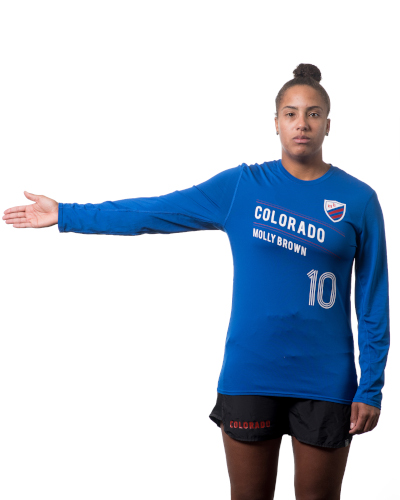
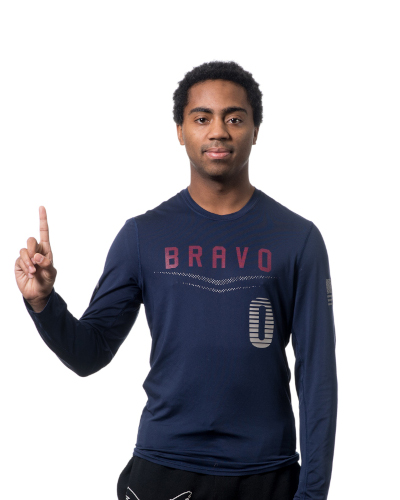
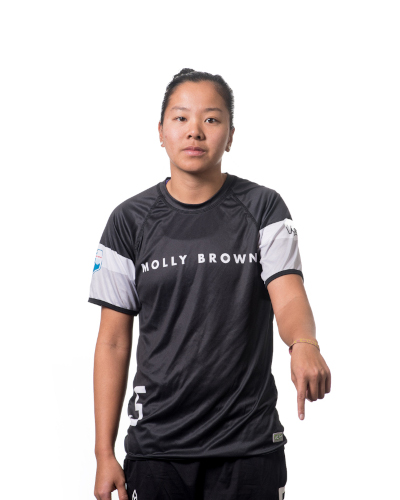
In- or out-of-bounds Disc up Disc down 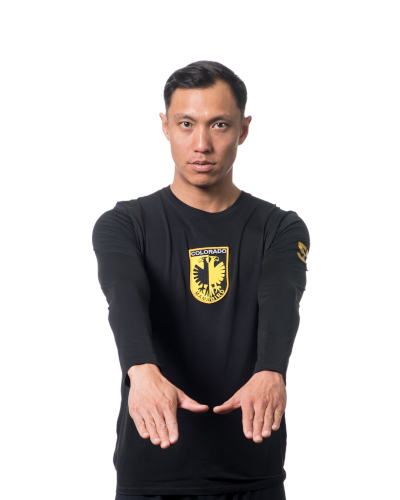

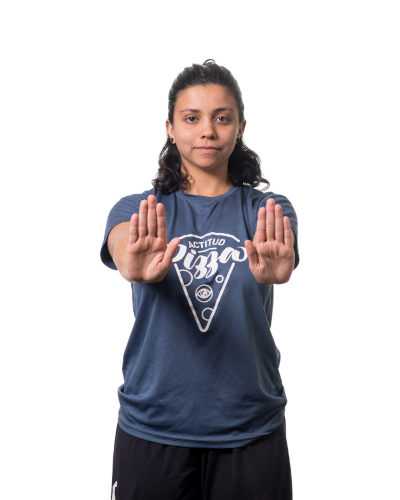
In the end zone Goal Force-out foul 
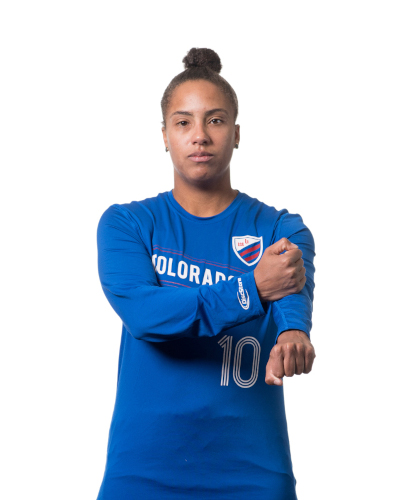
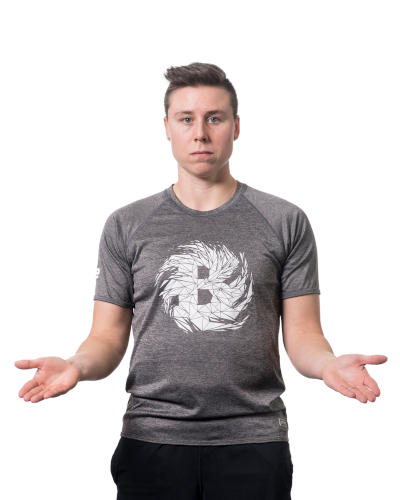
Bobble Foul No contest 
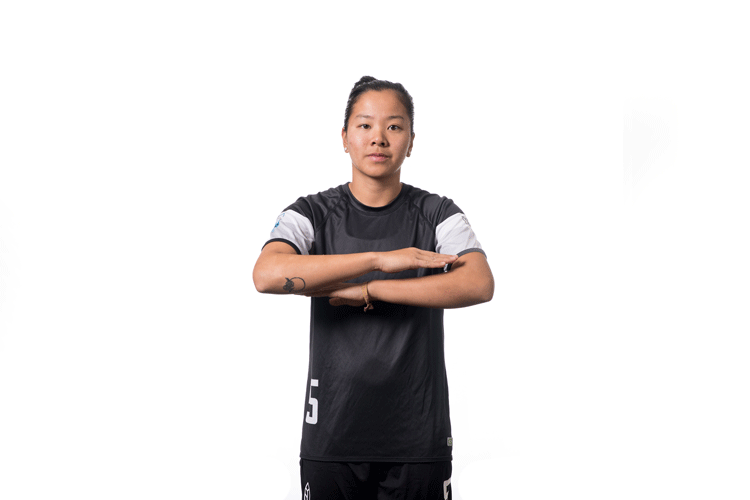
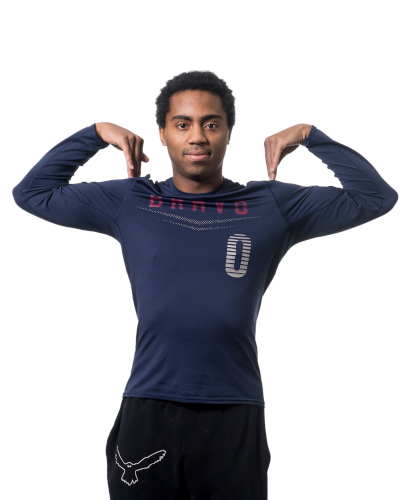
Contest Retraction (3 swipes) Injury timeout 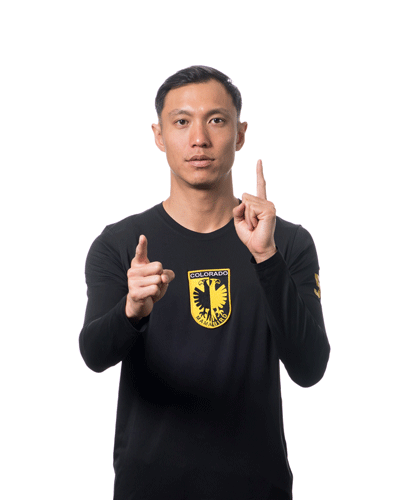
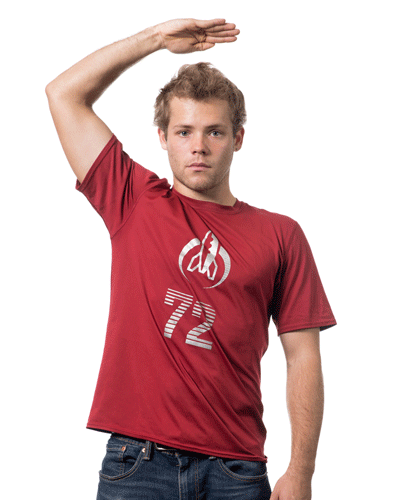

Injury substitution Disc uncatchable Pick 
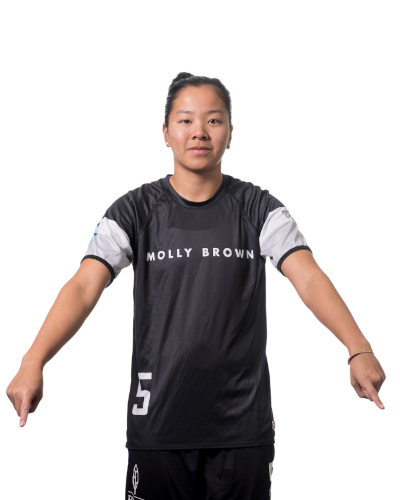
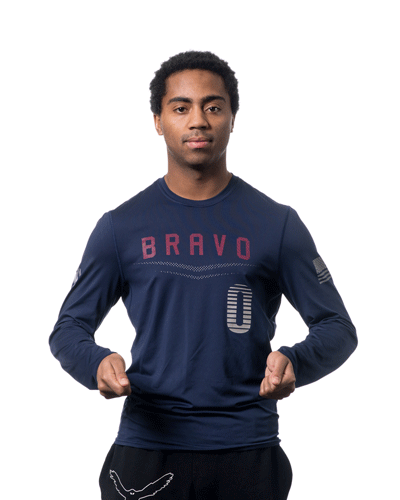
Travel Double team Disc space 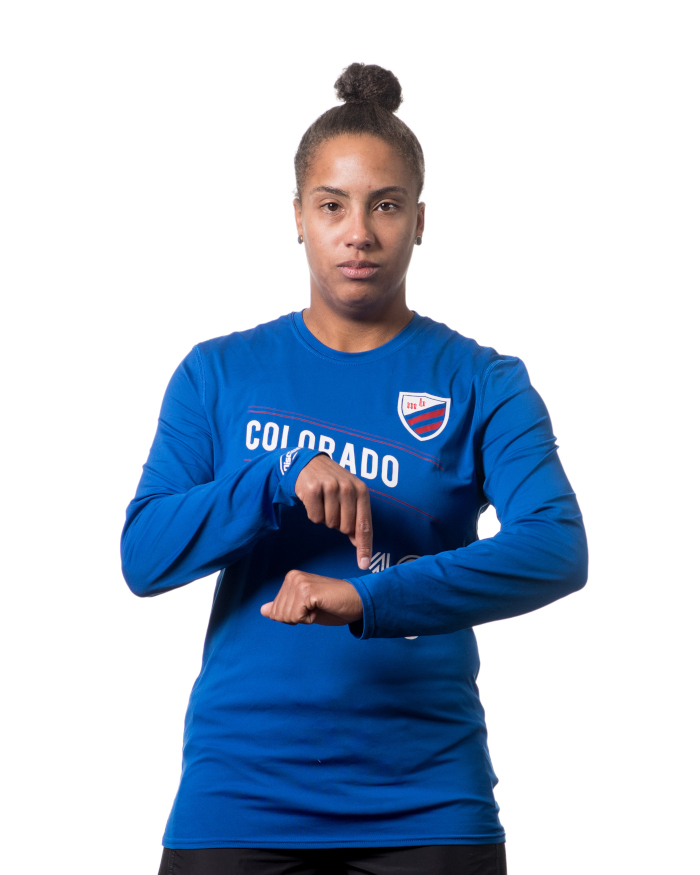
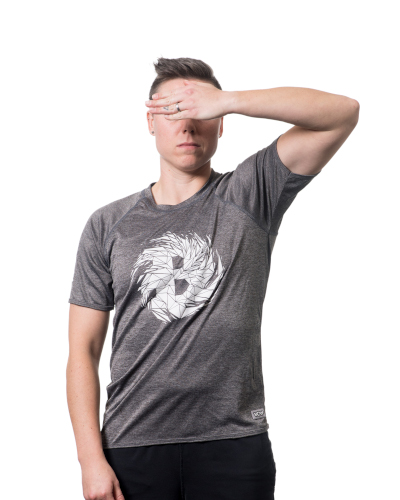
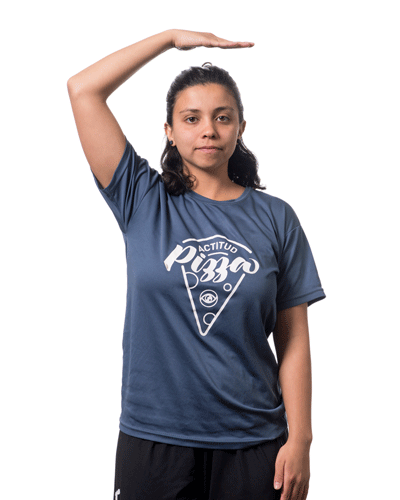
Fast count Vision blocking Stall or time violation 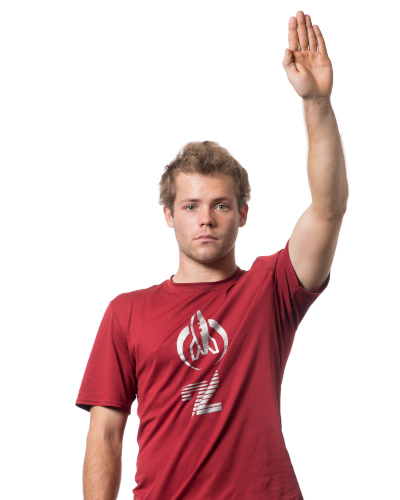
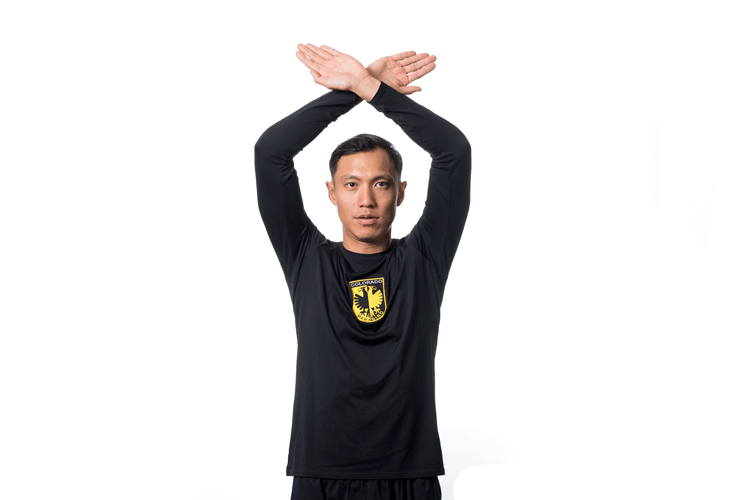
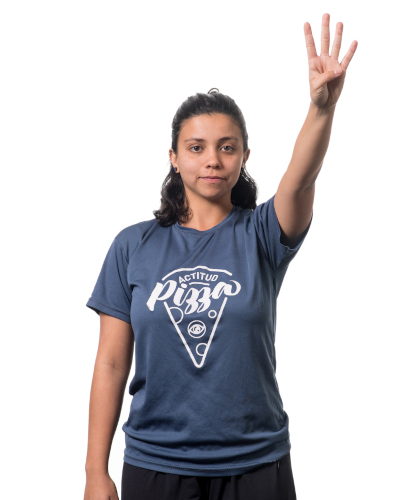
Readiness or brick Play has stopped Announce stall (use appropriate number of fingers) 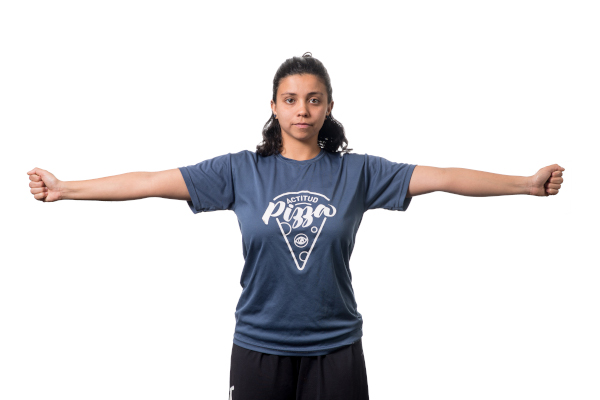
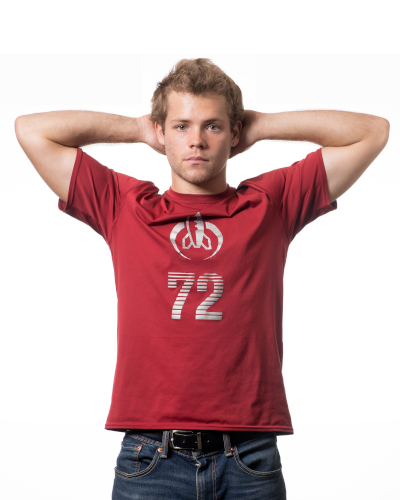
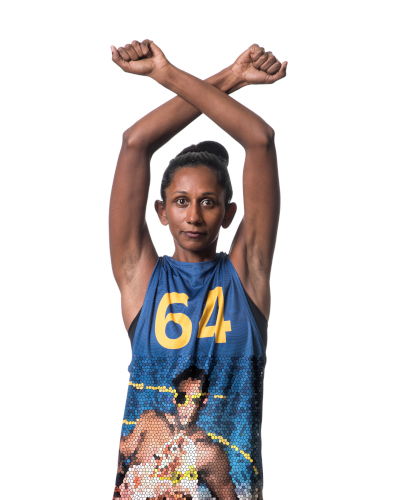
Gender ratio: 4 women-matching players Gender ratio: 4 men-matching players Offsides
(Arms straight, upward at a 45 degree angle, hands open, forming a “V” with your arms)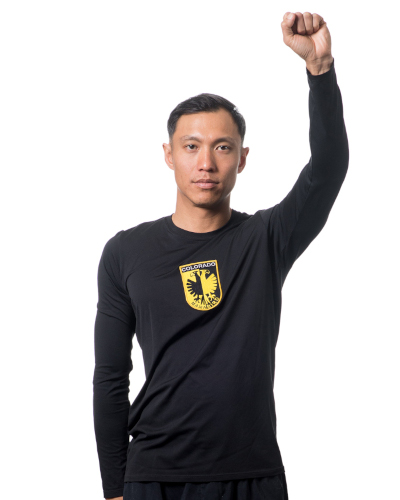
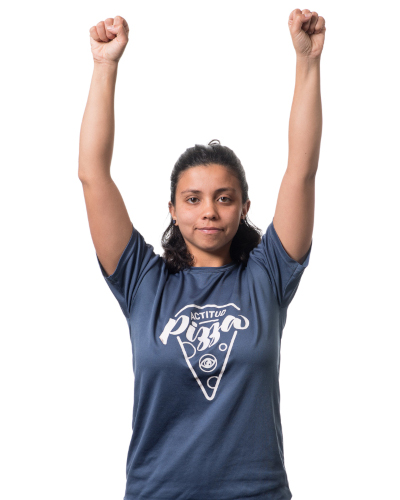
False start or violation 10 seconds 20 seconds 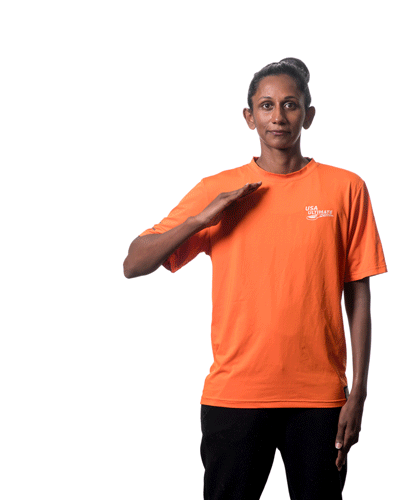
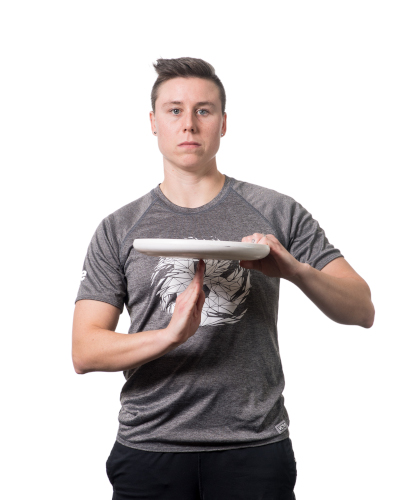
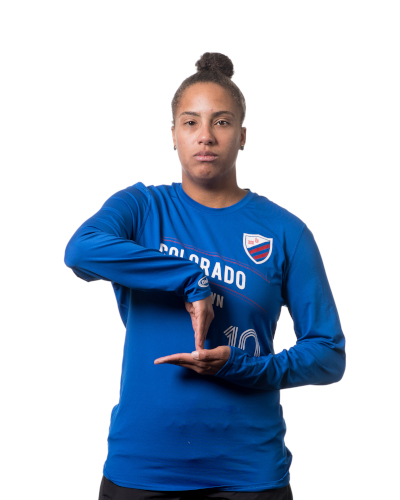
Pre-stall count Timeout Spirit timeout -
D2. Observer Only Hand Signals
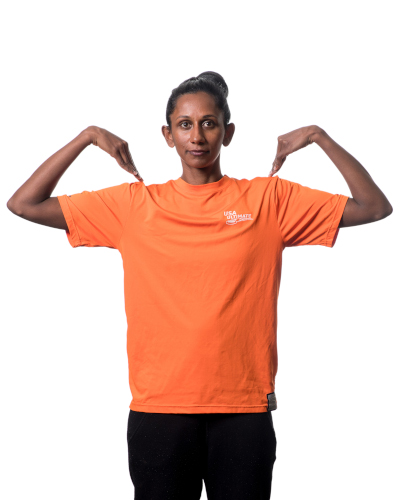
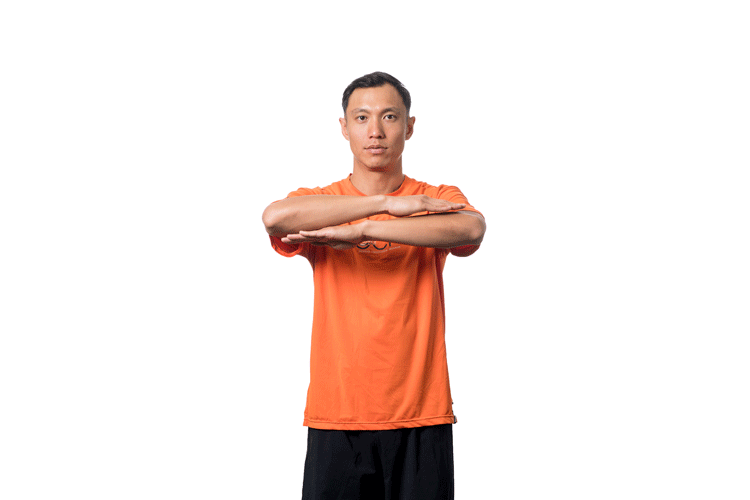
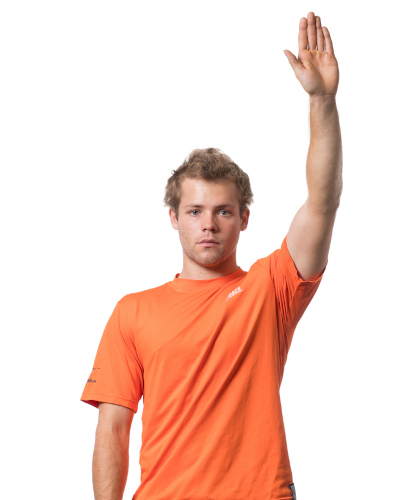
Observer ruling Observer overrule Call on field 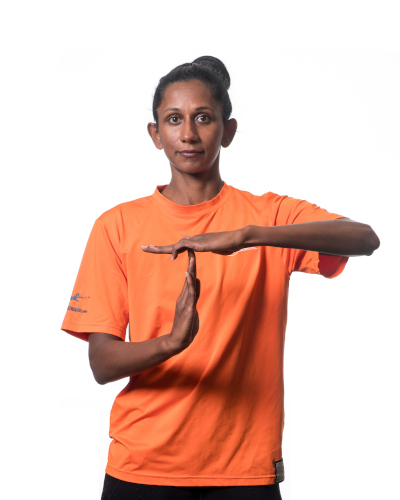
Timeout
-
D1. Player and Observer Hand Signals
-
Appendix E: Youth Rules Adaptations
The following adaptations to the rules are recommended for youth ultimate competitions, as defined below. These adaptations may be additions to the current official rules or may supersede existing rules. Other than these additions and changes, the current official rules will apply to youth competition.The goals for Youth Rules Adaptations are to modify the game to make it safer, more fun, and more developmentally appropriate for various age groups. These adaptations should be used with those goals in mind, rather than for strategic purposes. The current age categories are a general approximation of development levels, and are also in part based on factors such as school levels and the breakdown of current age groups participating in the sport. These will continue to be refined in the future.
-
E1. Requirements
- E1.A. There are not currently any requirements for rules adaptations for youth under this edition of the rules. Requirements may come in future editions based on continued research and experience with adapting the sport for youth age groups.
-
E2. Recommendations
- E2.A. These rule adaptations are not required, but are optional recommendations taken in whole or in part, to help younger players learn to play in a more developmentally appropriate environment.
Under-12 Under-15 Under-17/20 Disc size USA Ultimate-approved “Youth Level U-12” disc USA Ultimate-approved 175g disc USA Ultimate-approved 175g disc Number of players on the field 3v3 or 4v4 5v5 or 6v6 7v7 Field size (yards)
Length: Central Zone (goal line to goal line)3v3
Length: 25-35
Width: 15-20
End Zone: 5-10
Brick: 7-10
4v4
Length: 35-45
Width: 20-25
End Zone: 10-15
Brick: 10-135v5
Length: 45-55
Width: 25-35
End Zone: 12-18
Brick: 13-16
6v6
Length: 55-65
Width: 30-35
End Zone: 15-20
Brick: 16-18Standard rules. Game length Game Total
(range 9-11)
Hard Time Cap
(range 45-60 minutes)Game Total
(range 11-13)
Hard Time Cap
(range 60-75 minutes)Game Total
(range 13-15)
Hard Time Cap
(range 75-105 minutes)Time Between Points Coaches should communicate before the game about expectations for time between points. Coaches should communicate before the game about expectations for time between points. Add 20 seconds to the prescribed time limits for the receiving and pulling teams. In-Point Substitutions Organizers/coaches may agree to stop the game during a long point to substitute players. Specific rules around when and how this is implemented should be communicated ahead of the game. Organizers/coaches may agree to stop the game during a long point to substitute players. Specific rules around when and how this is implemented should be communicated ahead of the game. Standard rules. Pre-stall None None Standard rules. Dropped pull Not a turnover.
Play from where disc was dropped.
No stoppage.
Intended to teach catching the pull, not to be used simply to knock the pull out of the air.Not a turnover.
Play restarts with a defensive check after players on both teams have set up.
Intended to teach catching the pull, not to be used simply to knock the pull out of the air.Standard rules. Zone defense Not allowed. Must play match-up or person-to-person. Switching and poaching to provide help are allowed, but no defense designed to cover spaces rather than players. Standard rules.
Organizers/coaches may agree to restrict zone and only play match-up or person-to-person.Standard rules. Disc space Marking distance extended from disc width to arms-length. Marking distance extended from disc width to arms-length. Standard rules. Foot blocks Not allowed.
If a marker blocks a throw with a non-planted foot or leg, it is considered a marking foul.Standards rules. Emphasis must be placed by coaches on proper technique and decision-making, especially for new players. Standards rules. Emphasis must be placed by coaches on proper technique and decision-making, especially for new players. Travel calls Standard rules. Coaches encouraged to teach pivoting and not calling insignificant traveling violations. Standard rules. Coaches encouraged to teach pivoting and not calling insignificant traveling violations. Standard rules. Layout on Defense Not allowed.
Diving for a block on defense is considered a receiving foul.Allowed without contact.
Any contact with another player before, during, or after the play is considered a receiving foul. This includes incidental contact that did not affect the play.
Emphasis must be placed by coaches on proper technique and decision-making.Standard rules.
Emphasis must be placed by coaches on proper technique and decision-making to avoid contact.Dangerous play/receiving fouls Ultimate is a non-contact sport. Incidental contact can occur, but unlike some sports, blatant bumping and physicality are not acceptable. Please play safely and avoid contact whenever possible. Ultimate is a non-contact sport. Incidental contact can occur, but unlike some sports, blatant bumping and physicality are not acceptable. Please play safely and avoid contact whenever possible. Ultimate is a non-contact sport. Incidental contact can occur, but unlike some sports, blatant bumping and physicality are not acceptable. Please play safely and avoid contact whenever possible. Spiking Not allowed by default. Only allowed if spirit captains/coaches agree ahead of time. Not allowed by default. Only allowed if spirit captains/coaches agree ahead of time. Not allowed by default. Only allowed if spirit captains/coaches agree ahead of time. -
E1. Requirements
-
Appendix F: Beach Ultimate Rules Adaptations
The following adaptations to the rules are to be used in beach or sand ultimate competitions. These adaptations may be additions to the current official rules or may supersede existing rules. Other than these additions and changes, the current official rules will apply to beach or sand competition.
-
F1. Number of Players
- F1.A. The recommended number of players per team is either five (5) or four (4).
-
F2. Playing Field
- F2.A. 5v5 Field Dimensions
- F2.B. 4v4 Field Dimensions
-
F2.C. Perimeter and end zone lines are established with field lining tape (preferred) or rope.
- F2.C.1. The top of the tape is the portion of the field tape that is facing upwards. Should the tape twist along its length, the “top” is always the side that is facing up, even if that changes along the length.
- F2.D. The top of the perimeter lines is not part of the playing field and is out-of-bounds.
- F2.E. The area directly under the perimeter lines and all parts of the perimeter lines excluding the top of the tape are part of the playing field and in-bounds.
- F2.F. The top of the goal line is part of the central zone.
- F2.G. The area directly under the goal line and all parts of the goal line excluding the top of the tape are part of the end zone.
-
F3. Equipment
- F3.A. Shoes and cleats are not allowed. Players’ feet must be bare or only have a soft covering such as socks or tape.
- F4. Length of Game
-
F5. Sand Stoppages
- F5.A. Any player may briefly extend a stoppage of play to remove interfering sand from their face, but active play may not be stopped for this purpose.
-
F6. Sand Fouls
- F6.A. A sand foul occurs when a player causes sand to fly into an opponent’s face in a way that significantly interferes with their play, such as in the eyes or up their nose.
- F6.B. A sand foul is considered distinct and separate to the action that caused it and should be resolved separately as such.
-
F1. Number of Players
-
Appendix G: Ultimate 4’s Rules Adaptations
Overview – Ultimate 4’s is an exciting and accessible variation of ultimate adapted for smaller teams and smaller fields. Like other variations that use smaller numbers, such as Beach Ultimate, 4’s helps create an opportunity for more involvement from everyone on the field. With shorter stall counts, play moves at a faster pace, and the smaller field creates a space where more throwers can reach all areas of the field. The need for fewer people and less field space makes the sport more accessible in multiple ways. While played with most of the same rules as regulation ultimate, including field surface, matches consist of multiple short games rather than one long one. The first team to win two of the three games wins the match, a format which lends itself to exciting comebacks and thrilling tie-breakers.The following adaptations to the rules are to be used in Ultimate 4’s competition. These adaptations may be additions to the current official rules or may supersede existing rules. Other than these additions and changes, the current official rules apply to Ultimate 4’s competition.
Field size (yards)
Length: Central Zone (goal line to goal line)Central Zone Length: 37
Width: 25
End Zone: 8
Total Length: 53
Note: Total length is the approximate width of an American football field.Matches and Games Matches are best of 3 games.
The third game is not required if one team wins the first two games.Point Totals The first two games are to 5.
The third game, if necessary, is to 3.*Start of the Game The first game of the match (see “Point Totals”) begins according to Section 9.A. and the usual choice of end zone or possession. The initial choices are reversed at the start of the second game. If there is a tie-breaker game, then the teams fairly re-determine (according to Section 9.A) which team has the choice of end zone or possession.** Pull Each point starts with a pull, and teams switch ends of the field after each point, as normal, with the following exception.
Any pull that touches the out-of-bounds area results in a brick. This includes all perimeter lines and includes any contact with those out-of-bounds areas even after the pull has hit the ground.
The brick is at midfield.Time Between Pulls Time limits are adjusted as follows:
30 seconds: Offense must be lined up
45 seconds: Offense must signal readiness
60 seconds: Defense must pullStall Count Stalls are 7 seconds (starting with 1 going to 7).
Stall at the “S” in “seven.”
Stall counts resume as in 15.F with the following adaptations:- “9 if over 8” becomes “6 if over 5”
- “6 if over 5” becomes “4 if over 3”
-
Contested stall
- First call “5”
- Second and subsequent calls when due to a fast count “3”
Timeouts 1 timeout per team per game Point Differential/Tie Breaks in Pools in Tournament Format Add 3 bonus points for winning the first two games, in addition to actual point differential.*** Time of Game and Matches (caps) 20 minutes each for first 2 games
10 minutes for last game
Hard cap for first game
Hard cap for 2nd game (but can be started as soon as first game ends)
Hard cap for 3rd gameMixed Personnel Ratios Always 2 man-matching and 2 woman-matching mixed play As with any new rules variation, there is an opportunity to experiment with a number of elements outlined above. The following are suggestions for potential areas for experimentation.* The tie-break game could be extended from 3 to 5. This will impact the timing of the last game and the match as a whole, which would need to be extended.** Rather than re-determining choice at the start of the tie-break, the pull and sides could be determined by continuing the ongoing alternating sequence, automatically giving the team that wins the first game first possession in the tie-break. Or give the previous losing team first choice of side/possession in second (and third) games.*** The sweep point differential bonus could be adjusted up or down. Tie-breaks could also be considered that track games won/lost differential and gives a +1 game bonus to a sweep before moving on to point differential.
